Your cart is currently empty!
Category: Bad Newsletter
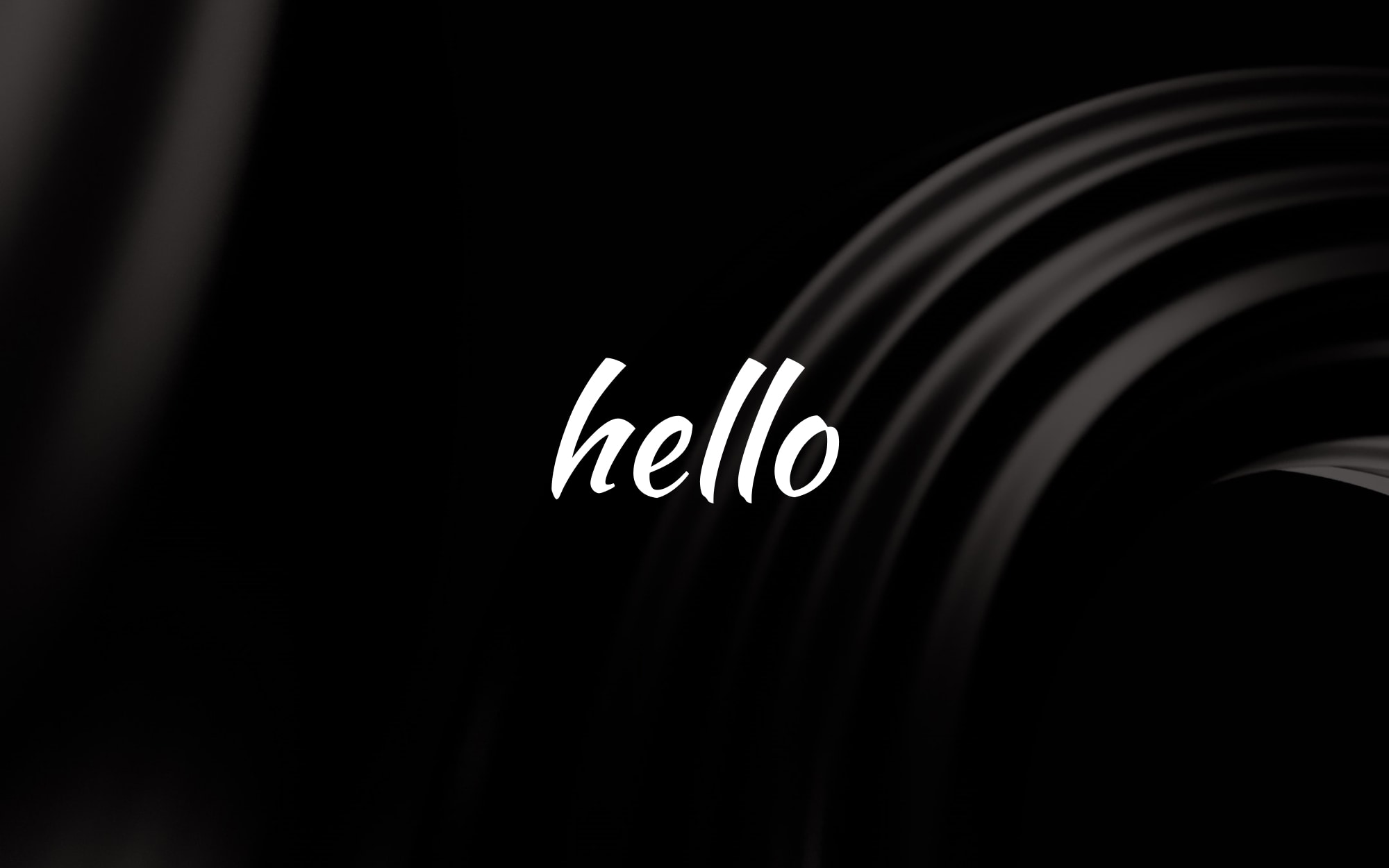
Coming now: the Ghost-powered Bad Newsletter
This is The Bad Newsletter, a brand new version of an old site by Joshua Drummond that’s just migrated from Substack. Things will be up and running here shortly, but you can subscribe in the meantime if you’d like to stay up to date and receive emails when new content is published!

Why is Stuff promoting right-wing propaganda?
The way New Zealand’s Taxpayers’ Union works should be obvious by now. This fake union — which is actually a neoliberal, ultra-capitalist lobby group acting in concert with a dense network of international right-wing think tanks called the Atlas Network — advances its agenda by carefully picking divisive issues and laundering them through the news media. Every story they land in a mainstream publication is a victory for them, and thanks to the news media’s addiction to conflict and its diminishment by market forces, the fake union and its think-tank bedfellows are having an easier ride than ever.
It probably shouldn’t be this easy, though. Witness this glorified press release masquerading as a story in Stuff, published on Christmas Eve, in the heart of the silly season:
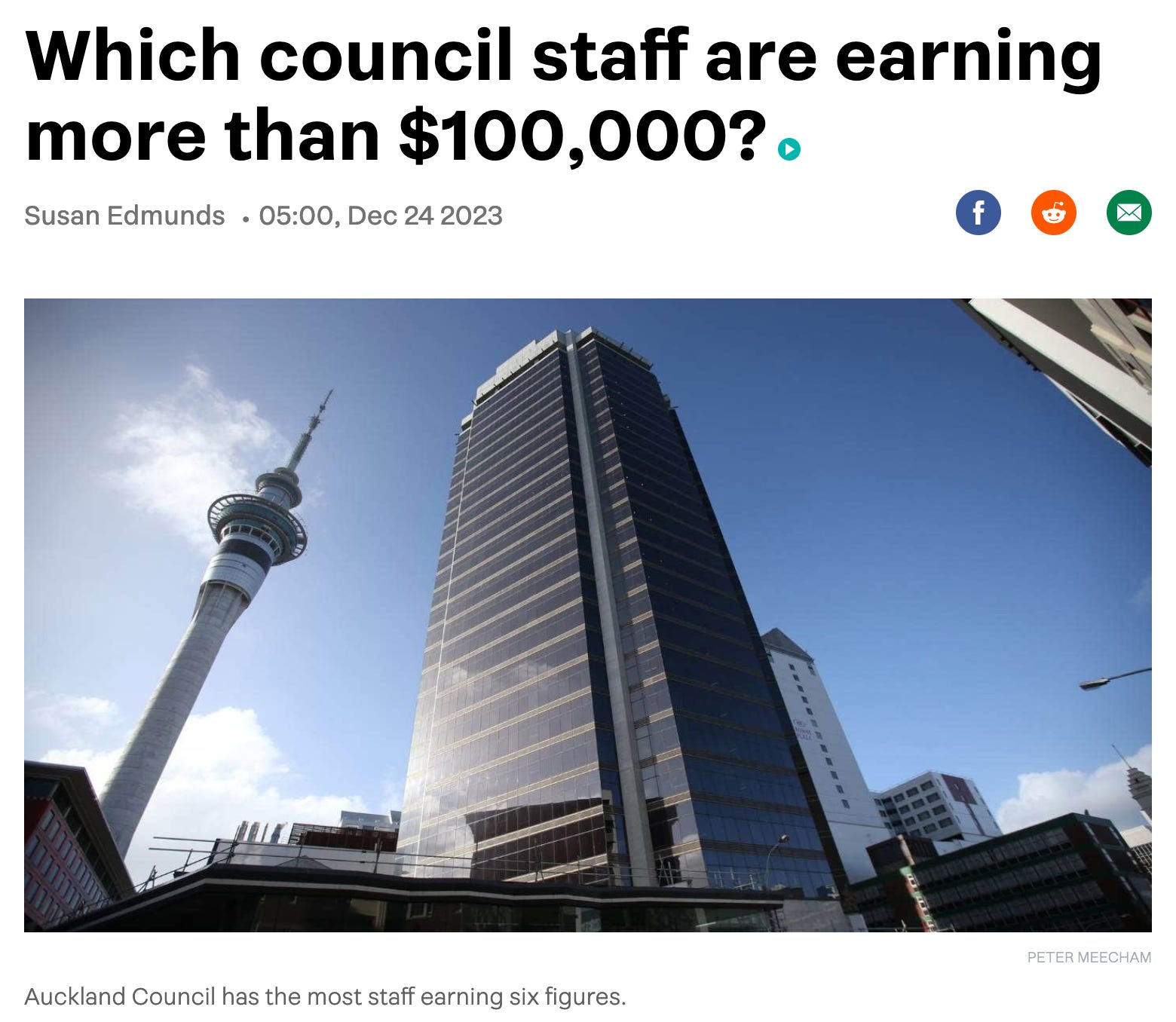
Merry Christmas, council workers! Your present this year is the Taxpayers’ Union talking about how you should be sacked, via the increasingly beleaguered Stuff, which has just disestablished much of its investigative journalism team. The story itself is… boring. The first bit is based squarely on (via what looks some heroic paraphrasing to avoid outright copying) a Taxpayers’ Union press release. The fact that some council staff earn over $100,000 is framed as shocking, when in fact it’s wildly unsurprising; the people who run cities and towns are doing a demanding job and they’re (sometimes) paid well for it. And that’s what the article itself says, a third of the way through, citing Infometrics (an economic consultancy based in Wellington.)
Infometrics chief forecaster Gareth Kiernan said he would expect roles in larger councils to be paid more than equivalent roles in smaller councils, particularly at the higher levels.
Near the end comes a missive from Connor Molloy, Campaign Manager for the Taxpayers’ Union (who are not identified in the story as anything other than “the Taxpayers’ Union,” with no explanation for readers that the “union” is a right-wing lobby group.) Molloy, of course, seems to think that the best Christmas present for council staff is for them to lose their jobs:
Connor Molloy, campaigns manager for the Taxpayers’ Union, said reducing the number of highly-paid “backroom” staff was the right thing to do if councils were threatening big rate hikes.
“Rather than going straight for core services like rubbish collection and libraries, councils ought to look inwards at their own bloated bureaucracies first when looking to make savings.
From a quick scan, this story seems like merely another example of the TPU successfully “placing” a piece of its neoliberal propaganda in the media, which happens — to the media’s vast detriment — all the time. But on a closer look, things get even bleaker.
Reading the story, a little blue hyperlink in the opening paragraph caught my eye, as it’s designed to do.
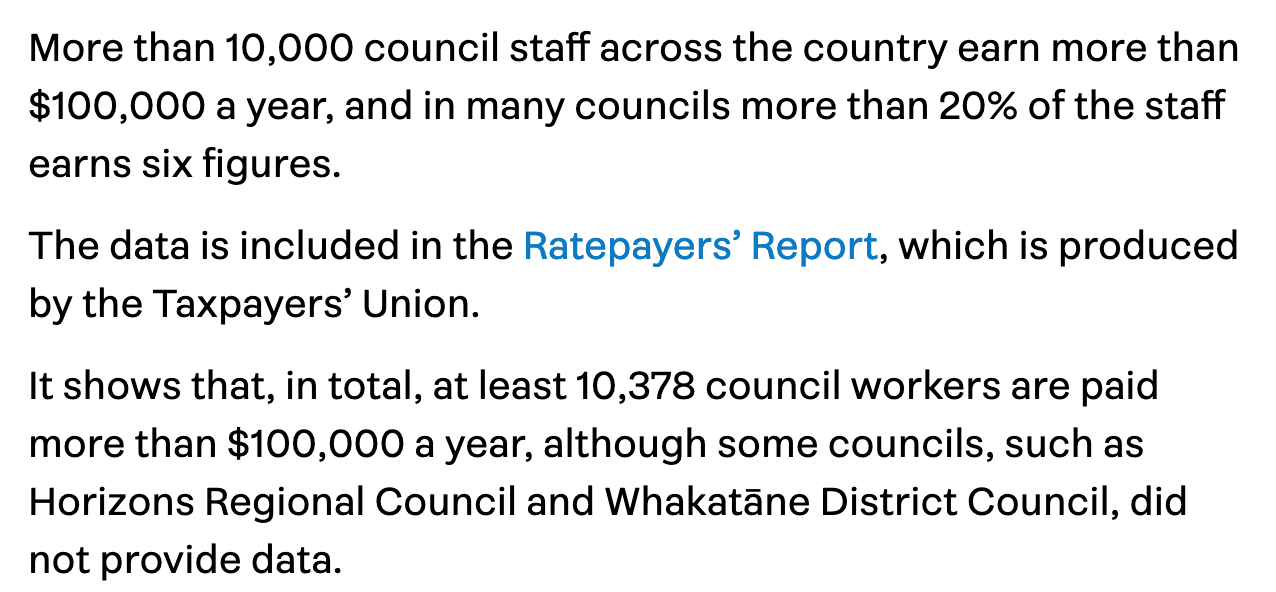
Curious! I wanted, as many readers might, to see the raw data informing the story. I was mystified as to why Stuff weren’t just hosting it themselves, or embedding the data on their page, as is standard practice for news organisations, which just made me curiouser.
I clicked through.
The page I landed on looks like this.

Hmm. Looks like I just need to put my email address in this handy form and I’ll get to see the report! You can even choose to be one of the three types of person: an “Elected official,” “Ratepayer,” or “Journalist (or reseracher.)1”
I’ll just pop my details in and click “VIEW REPORT” and…huh? It’s just a normal webpage! No need for an email address at all!
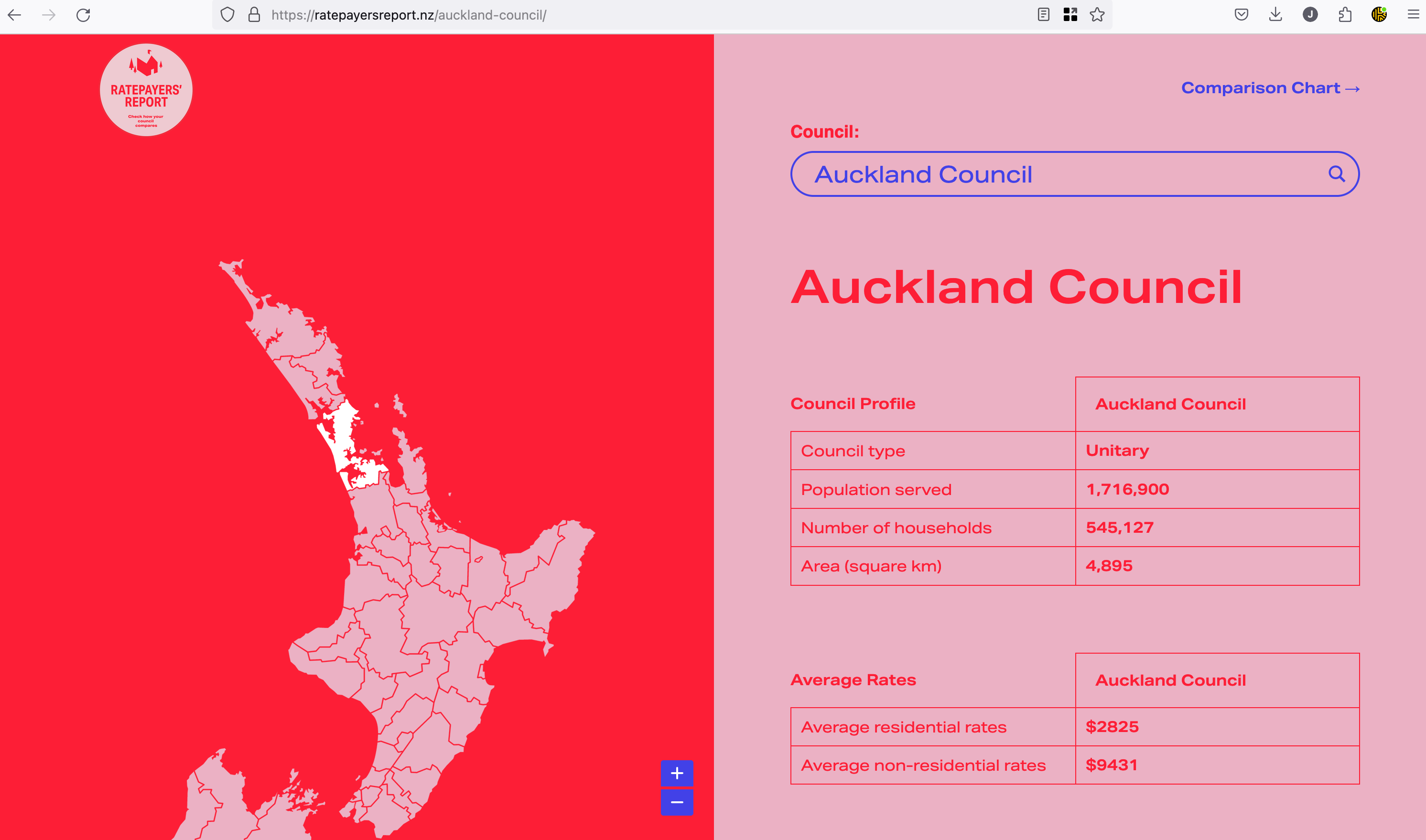
Look at that URL. That’s not a hidden or gated page: if the website was designed to be user-friendly, you could navigate straight to it. You don’t need to put in an email address to access the data, but the page is designed explicitly to make it seem like you do.
Do you at least get emailed the report? Like hell. Nothing shows up in your inbox until a few days later, when a horrifically-formatted email arrives and it’s made clear you’ve been added to a Taxpayers’ Union mailing list.
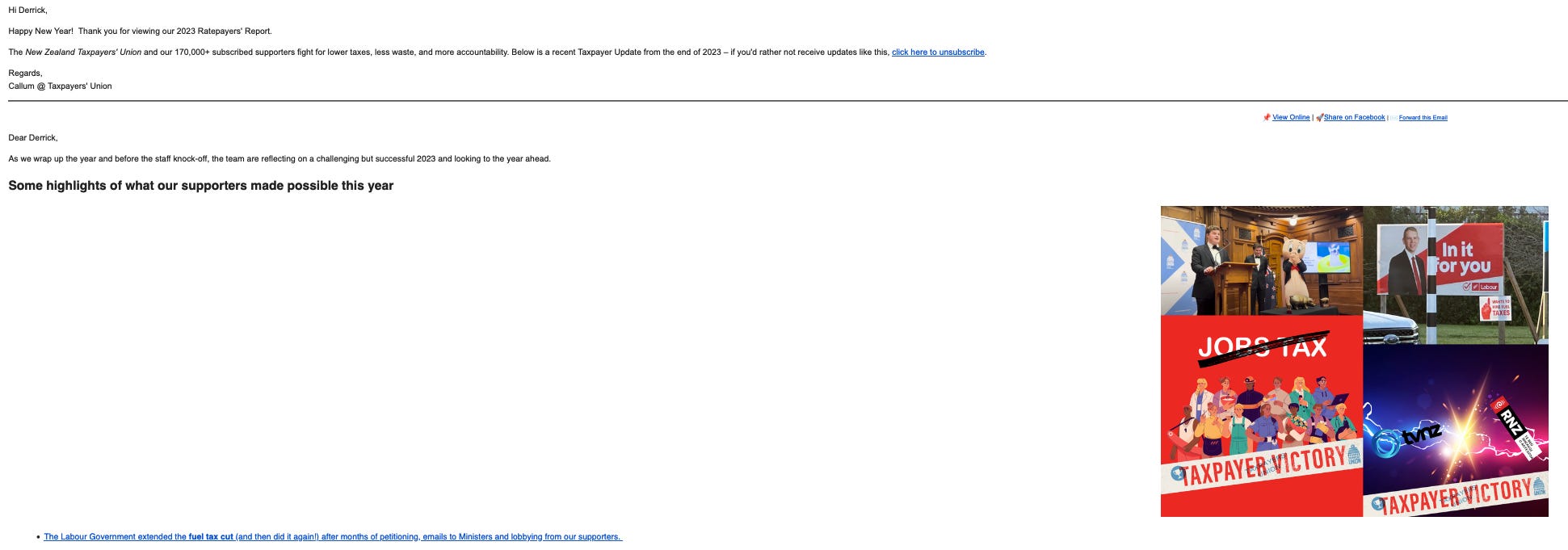
Take another look at that first form up there. There’s nothing whatsoever to indicate that you’re signing up to a mailing list. Not even a pre-checked “yes, send me Taxpayers’ Union emails,” checkbox. It’s either very poorly designed or deliberately misleading: either way, it could easily be illegal, under New Zealand’s Unsolicited Electronic Messages Act (2007).
So this is where we’re at. Stuff isn’t just parroting Taxpayers’ Union propaganda and enthusiastically leaning in to their “government = waste = fire them all” framing; they’re encouraging their readers to visit a website that harvests their emails and, unasked, signs them up for the full TPU package.
If you’re thinking “this seems bad!” well, I have more: want to know where this overtly propagandistic Ratepayers’ Report that shills for a right-wing lobby group originally comes from?
It was born as a collaboration between Stuff and the Taxpayers’ Union.
Don’t take my word for it: here’s the TPU press release.
The New Zealand Taxpayers’ Union, in collaboration with Fairfax Media has today launched “Ratepayers’ Report” hosted by Stuff.co.nz (…) “For the first time, New Zealanders now have an interactive online tool to compare their local council to those of the rest of the country,” says Jordan Williams, Executive Director of the Taxpayers’ Union. “Ratepayers can visit ratepayersreport.co.nz to compare their local council including average rates, debt per ratepayer and even CEO salaries.”
That was back in 2014. But at least the 2014 Ratepayers Report was hosted on Stuff’s own site, and didn’t speciously sign its users up to spam. It looked like this:
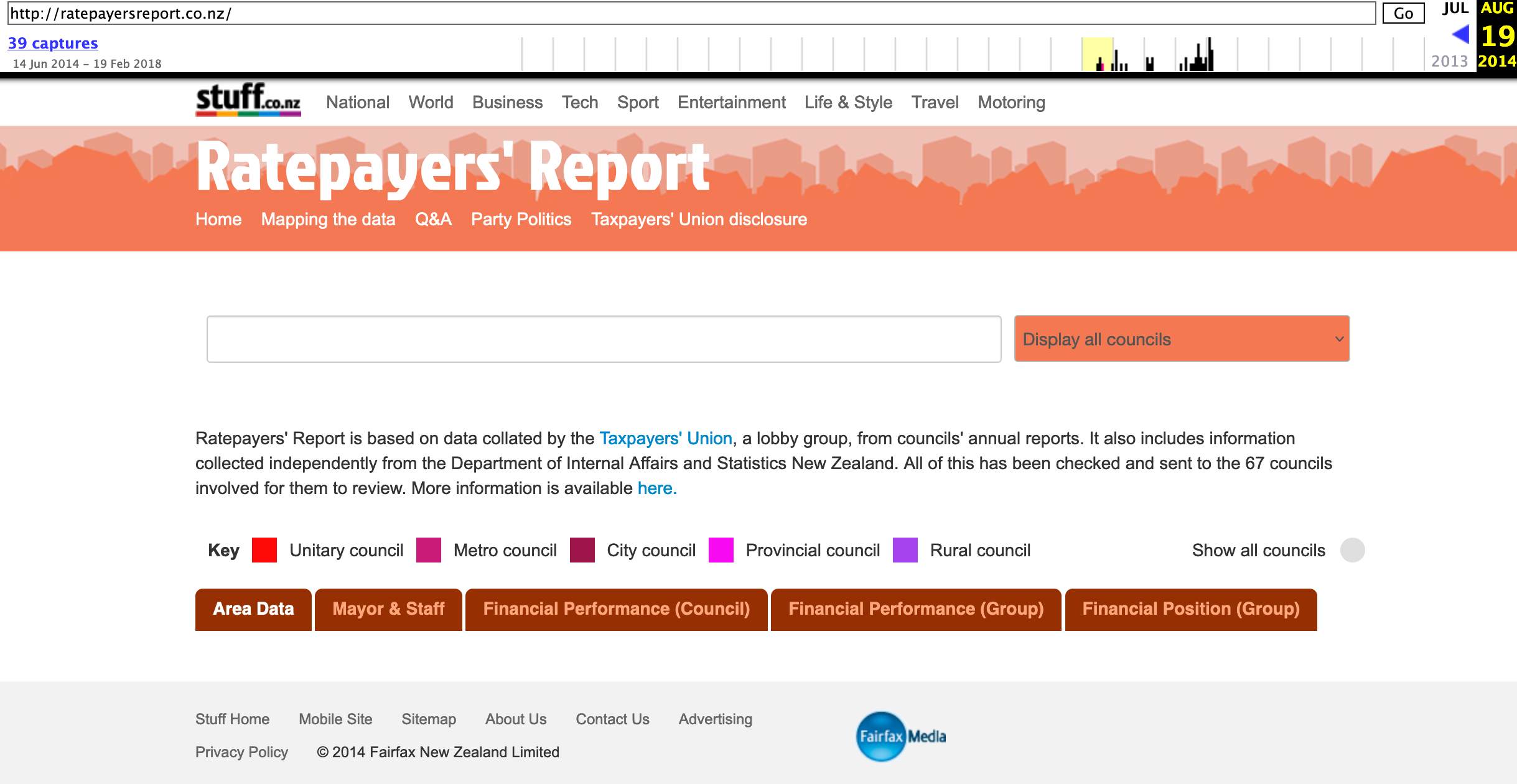
Nearly a decade later, the Ratepayers’ Report, together with a payload of TPU propaganda, is embedded in news cycles. The Taxpayers’ Union puts it out regularly, and media publish obligingly. A Google search of the Stuff site for “Ratepayers’ Report” shows you how entrenched it is.

This is how the Atlas Network right-wing sausage factory works: their junk “think tanks” propagate their neoliberal message and exploit the decline of media by doing journalists’ work for them. They’ve been doing it for years, and it’s been wildly successful, to the point that they’ve just released a book skiting about how manipulative they are. But this — a reputable news site sending its readers to sign up directly, and probably unknowingly, for TPU propaganda — seemed beyond the pale. What was going on? I wanted to know, so I put the following questions to Stuff.
- Why is Stuff linking to a Taxpayers’ Union email harvesting site?
- Was Stuff aware that the function of the Ratepayer’s Report was at least partially to harvest emails for the Taxpayers’ Union?
- What is Stuff’s policy on linking to external sites, especially those that may act maliciously or harvest user details?
- In your view, was the nature of the Ratepayer’s Report website (and its email-harvesting capability) sufficiently disclosed to readers?
- What is the present nature of the relationship between Stuff and the Taxpayers’ Union?
- Referring to the press release above, what is the past nature of the relationship between Stuff and the Taxpayers’ Union?
- Was this a commercial relationship, i.e. did either TPU or Stuff pay each other for participation in the Ratepayer’s Report? Was there contra, or an exchange of services?
- Does the relationship between Stuff and the TPU that established the Ratepayer’s Report persist today?
- If not, when did it end, and why did it end?
- Does Stuff have guidelines for journalists (or editors) who utilise the work of lobby groups in their stories, perhaps along the lines of the BBC? I refer to this page, which states:
Contributors’ Affiliations
4.3.12 We should not automatically assume that contributors from other organisations (such as academics, journalists, researchers and representatives of charities and think-tanks) are unbiased. Appropriate information about their affiliations, funding and particular viewpoints should be made available to the audience, when relevant to the context.
If so, can you please provide me or point me to a copy of these guidelines?
Further to the above question, why does the story not identify for readers who the Taxpayers’ Union is, and what their work entails? I refer to these Newsroom stories that make it clear that the TPU is a neoliberal, right-wing lobby group, with links to fossil fuel and tobacco concerns, as well as being part of the international Atlas Network of neoliberal, right-wing think-tanks.
I note also that this Stuff story (correctly) identifies the Taxpayers’ Union as a “right-wing pressure group,” so clearly it’s possible to be upfront about the group and their motivations when writing a story about the TPU’s work and the concerns they raise. Given this, why isn’t this clear identification the norm across Stuff?
A day later, Stuff replied, with a comment they asked to be attributed to Keith Lynch, Editor-in-Chief of Stuff Digital:
Stuff has no formal relationship with the Taxpayer’s Union. A report from the Taxpayers Union was transparently quoted in the story alongside information from other named sources. In this case, the link to the source was included so audiences could access the information referenced in the story, should they wish.
On reflection, we have now updated the story to remove the link.
There you go, Stuff readers: four sentences and one middle finger. Wondering why Stuff saw fit to partner with the TPU? When the partnership ended? Why it ended? What their guidelines are when handling the journalistic equivalent of radioactive waste — the propaganda created by think tanks to shape society in their image? Screw you. You don’t get to know. The hyperlink to the Taxpayers’ Union site that misleadingly harvests readers’ emails is gone (without so much as an edit notice or correction on the page) because it should never have been there in the first place — but as for the merest whisper of explanation as to why the TPU so often gets such an easy ride in media?
Nothing.
I replied, asking Stuff if they’d be giving my other questions actual answers. I didn’t hear back. It’s amazing, really: journalists hound politicians endlessly to just Answer The Question (as they should!), but when it’s them on the hook they provide weasel words that’d do any politician proud, and then evaporate into the ether.
Going back to the Stuff story one last time, I saw this little banner above the body copy.

You care about our money? I bet you do. Here’s a thought, Stuff: how about showing that you care about your audience? Stop feeding them repurposed think-tank propaganda, own your mistakes, and act with integrity. Perhaps, instead of taking the Taxpayers’ Union at their obviously-compromised word, you could talk about how the TPU used racist insinuations about “co-governance” to fight Three Waters, a government program designed to fix horrifically neglected water infrastructure while freeing councils from paying for it — the repeal of which is now being cited by councils as a key reason for massive rate hikes.
Maybe then people would be more inclined to pay you, instead of mistrusting you.
In a world where misinformation is so easily spread, the mainstream press should be fighting it, not amplifying it. It’s too bad that Stuff seems incapable of assuring its readers that it will treat think-tank content with the caution it warrants.
-
Sic. ↩

A Simple Nullity
An incredibly important documentary went live today, and I don’t want you to miss it.
“Trick or Treaty? Indigenous rights, referendums and the Treaty of Waitangi” is a deep dive on how right-wing influence networks in Australia joined forces to destroy Australia’s Indigenous Voice to Parliament — and how the same forces are at work in New Zealand. I’ve taken an interest in New Zealand’s gaggle of lobby groups for a long time now, so I was very pleased to do research for the doco and work with award-winning producers and top-tier journos Mihingarangi Forbes and Annabelle Lee-Mather. I also appear on camera, which is less my thing, but as an Aussie-born Kiwi the subject is very close to my heart, and I didn’t want to miss the chance to tell what I think is a vital story.
Much of what’s in the doco is far from secret, particularly to those in the media-politics confluence; but (crucially) it is not well known by the general public. The short version is that there are a bunch of well-funded, right-wing, neoliberal influence and lobbying groups in New Zealand, who share links with similar groups overseas. They are ostensibly independent groups, but they coordinate their activities, share resources, trade personnel, and — when you zoom out slightly — essentially work as one large body. In fact, several of the groups officially operate under the auspices of one giant neoliberal anthill organisation, called the Atlas Network. In New Zealand, these groups — and the individuals who work in them — tend to cluster around parties like ACT, NZ First, and National. Their modus operandi is to write stultifyingly dull papers, create model legislation, get pet MPs and parties elected, and incessantly insert their messaging into the public consciousness via the media. That messaging varies from group to group, but the (almost invariable) common denominator is this:
They consistently oppose both climate action and recognition of indigenous rights.1
Having seen extraordinary success in Australia with the triumph of the “No” vote on the Voice, these same forces look to be coming for Te Tiriti o Waitangi. Since it gained limited judicial and legislative recognition, Te Tiriti has been a bugbear for neoliberals. It represents everything they hate: an example of collective recognition and responsibility, and an admission that indigenous people do in fact have continuing inalienable rights that pre-date colonisation. Perhaps most importantly, Te Tiriti acts as a potential handbrake on the kind of unfettered property rights required for mining and fossil fuel companies to prosper.
So it’s no surprise that the ACT Party and lobbyist enablers like Hobson’s Pledge want nothing more than to get rid of it.
Wherefore referendum
In the doco, I’m asked if I think there will be a referendum on Te Tiriti. My answer is yes: in my opinion, it only really remains to be seen what form the referendum will take. There are two options: a government-initiated referendum or a citizens-initiated referendum. For the first option: the coalition agreement between National and ACT specifically calls for ACT’s Treaty Principles Bill to be advanced to select committee: National have pointedly not committed to a referendum but to ACT Party leader David Seymour, it’s clearly still on the cards.
The other option is a citizen’s initiated referendum or CIR: anti-Tiriti group Hobson’s Pledge, co-founded by former ACT Party leader Don Brash, is already lobbying for one. Anyone can get a CIR before Parliament; all that’s required is the signatures of ten percent of registered voters. For an issue like Te Tiriti, long a lightning rod for cranks, racists, and the terminally uninformed, 370,000-ish signatures should be a snap.
In my opinion, either option stands a very real risk of ripping the country apart, on a scale not seen since the Springbok tour protests or perhaps even the Land Wars. And I also think that ACT’s proposed Treaty principles — on top of the other anti-Tiriti measures being undertaken by the ACT/NZ First/National government — would be the most profound assault on indigenous rights in Aotearoa since the racist Justice James Prendergast declared the Treaty a “simple nullity.”
Maps of Meaning
In the doco, there are a few shots of me using a program that looks like a digital spiderweb. I like that it’s been included, because it’s becoming a big part of my writing process. Obsidian is a note-taking program that allows users to write in Markdown, and easily link notes to each other. I’d recommend it to journalists everywhere — it’s encrypted, open-source, and great for brain-dumping and research. One of its nifty features is its mind map or “graph view,” functionality, which showcases all your notes and how they link to each other.

That, I’m very aware, is essentially a computer version of this:

Mind maps have a bad name, thanks to conspiracy theorists and very funny sketches based on conspiracist antics, but they’re a really useful visual tool for research. What’s obvious on viewing the mind map I’ve made — which, to be clear, is comprised primarily of publicly-available information listed on the websites of the organisations I’m researching — is just how entwined everybody is. New Zealand is a small country, to be sure, but after a few hours it becomes very clear that the favourite hobby of these lobby organisations is giving each other jobs. The boards are stacked with fixtures of the “business community” — the very elites that these same organisations so often rail against — and a scan of member’s employment histories often reveals them bouncing around related orgs like pinballs. New NZ First MP Casey Costello, to pick one name more or less at random, has previously worked for (or with) the Taxpayer’s Union, Hobson’s Pledge, and ACT. Each organisation is so entwined with the others that they start to look, accurately, like the same body.
The media is the message
One of the best things about this documentary is that it gives New Zealanders something Australians missed out on: a primer on who these interconnected neoliberal groups are and how they operate. While they have many channels to their audience, like newsletters and social media, the most important medium is still the mainstream media. One of the things I said during shooting that didn’t make the final cut is that the New Zealand media is “infected with lobbyists” — and it is. Lobbyists and their ilk advance their agenda in the media through the following methods:
- Giving journalists their phone numbers and never failing, as I mention in the doco, to pick up when it rings, to deliver some variation on “the world’s richest and most sociopathic people are right, actually.”
- Combining a never-ending deluge of press releases with juicy scoops and leaks of the “ya didn’t hear it from me but boy have I gotta story for YOU. You’ll never guess how much funding this poet got!” variety, usually supplied to pet journalists and right-wing media orgs who can be relied upon to advance the lobbyist’s agenda. See also: Newstalk ZB.
- Providing enticingly conflict-loaded “insider” opinions for free or very cheap to cash-strapped editors and producers, with the tangible result that a huge proportion of New Zealand’s opinion columnists, podcasters, and other varieties of talking head are paid lobbyists of some kind, which brings me to:
- Getting actual media jobs, which has everything to do with a laissez-faire media culture that pretends not to notice the constantly revolving door at the axis of business, politics, and journalism. Numerous examples include New Zealand Institute asset Luke Malpass waltzing into the job of political editor at Stuff, a position he wields with all the impartiality of a used car salesman; ex-National leader Simon Bridges failing into a podcast at Stuff; New Zealand Institute sleep aid Eric Crampton’s spot at Newsroom; Muriel Newman (the founder of unhinged climate-denying lobby group NZCPR) being slung a new gig at Newstalk ZB; long-time right-wing lobbyist Matthew Hooton getting a seemingly eternal opinionist gig at NZME; and his (current? former? I don’t know, and neither do you, because the media outlets he appears on often don’t deign to tell us) consigliere Ben Thomas, who rejoices in the lifetime appointment of Chief Migraine Officer on the Spinoff’s exhausting political podcast, Gone By Lunchtime.
Given the noble Fourth Estate functions essentially as a base of operations for influence operators, what can be done? Lots, in my opinion:
-
Short of proper lobbying finance and influence disclosure law, which are all but impossible under the present Government but might be an option when they disintegrate, the media can start by voluntarily and transparently showcasing the bona fides of its talking heads. Every time a lobbyist shows up to generously peddle influence and build their own profile, their appearance can be marked with a disclaimer showing exactly who they have a.) previously worked for and b.) are working for now. That’s really the least that should be done: audiences desperately need to know which talking heads are on the take2.
-
News media can also choose to identify when stories have been shopped to them by members of astroturf influence organisations like the Taxpayer’s Union, or (more ideally) refuse to run their hit pieces.
-
Media should identify and label influence groups accurately: for example, identifying a spokesperson as being from the benign-sounding “New Zealand Institute” tells an audience nothing: labelling the New Zealand Institute (accurately) as a “neoliberal lobby group for ultra-free-market economics with representation from some of the biggest corporates in New Zealand on its board” tells audiences what they need to know.
-
Media should also proactively highlight when their employees are intimately linked to lobby groups or politicians, which is (especially in the Press Gallery) much more common than non-media people might think. Such is the case with Newshub’s Political Editor Jenna Lynch, who is married to ACT Party Chief of Staff Andrew Ketels. It doesn’t matter if she’s the world’s most scrupulous reporter who somehow manages never to discuss politics with her husband: it’s a very obvious potential conflict of interest, and audiences deserve to know about it — and any other such conflicts.
-
As a final suggestion, the media should also stop giving prime opinion and airwave real estate to the world’s most boring politicians because of the more-common-than-you think reasoning of “oh, they were such a hoot when we got on the piss that one time.” Their audiences will fervently thank them.
Thanks for checking out the documentary. Please share it far and wide: I think there’s a lot in there that New Zealanders both deserve and need to know.
-
The New Zealand Initiative hotly denies they are climate deniers, by pointing out that they accept the reality of climate change and that they support the Emissions Trading Scheme, but they also lobby stringently against any and all climate action that isn’t the ETS. This is easily understandable given the fact that that the ETS is set up as a literal licence for corporations to continue with carbon pollution, as well as a way for the rich to get richer trading in carbon credits. ↩
-
In this spirit of transparency, you should know that I was once a paid member of both the Civilian and the Green political parties. I was directly involved in neither organisation and my membership in the respective parties lapsed when it wound up and I forgot to pay my sub. From memory the total expenditure amounted to twenty-five bucks. ↩

The Hand That Feeds
A short lunchtime post today. Let’s begin with a (gift) link to an Atlantic story revealing Substack’s Nazi problem. How bad is is it here? This bad:
At least 16 of the newsletters that I reviewed have overt Nazi symbols, including the swastika and the sonnenrad, in their logos or in prominent graphics. Andkon’s Reich Press, for example, calls itself “a National Socialist newsletter”; its logo shows Nazi banners on Berlin’s Brandenburg Gate, and one recent post features a racist caricature of a Chinese person. A Substack called White-Papers, bearing the tagline “Your pro-White policy destination,” is one of several that openly promote the “Great Replacement” conspiracy theory that inspired deadly mass shootings at a Pittsburgh, Pennsylvania, synagogue; two Christchurch, New Zealand, mosques; an El Paso, Texas, Walmart; and a Buffalo, New York, supermarket. Other newsletters make prominent references to the “Jewish Question.” Several are run by nationally prominent white nationalists; at least four are run by organizers of the 2017 “Unite the Right” rally in Charlottesville, Virginia—including the rally’s most notorious organizer, Richard Spencer.
The rest of the article is just as damning. I am only annoyed that I didn’t write about it myself; Nazi content on this website isn’t hard to find, and I could have reported on it much earlier. That said, I am glad that a mainstream publication is addressing the issue.
It’s been known about for a long time, and Substack, to its enormous discredit, has done nothing about it. Instead, they’ve worked to explicitly elevate “alt-right” types like Richard Hanania, with this simpering puff piece and accompanying podcast by Substack cofounder Hamish McKenzie. When Huffington Post writer Christopher Mathias revealed Haniana’s past as an overt white supremacist writing under the pseudonym “Richard Hoste,” Substack’s silence was deafening. They did not retract or otherwise repudiate their article, or even really address the controversy. As the Atlantic article makes clear, Substack already has terms of use that ban “hate,” but they’re not enforcing them. Instead they’re striving to be edgy, sucking up to weirdo Silicon Valley accelerationists, and making cringeworthy ads:
Please note this isn’t about encouraging “free speech,” a position I have a lot of sympathy for, because Substack aren’t genuine free speech maximalists. If they were, they’d allow all non-criminal speech, including explicitly protected and legal forms of free speech like pornography and other kinds of sex work. They don’t, and this makes them free speech hypocrites.
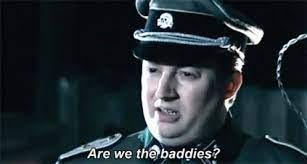
With Substack’s Nazi problem now very much out in the open, the platform now has a choice: enforce their terms of use and evict the vile people who make a living (and make money for Substack) by peddling overt hate to huge audiences, or maintain their current course and become a Nazi bar. I suspect they’ll pick option B, which sucks. I have good friends who make their entire living from writing on Substack and the platform’s hypocritical, ideologically inconsistent free-speech-for-Nazis-but-not-for-boobies policy is putting writers in a terrible position. If they stay, it looks like they’re okay with being on a platform that doesn’t just permit but promotes hate. If they leave, they risk losing their livelihood.
Clearly, organised opposition is what’s needed. If this site’s writers banded together and threatened to leave Substack en masse, the resulting revenue hit might make continued Nazi-coddling untenable. Writers are already organising:
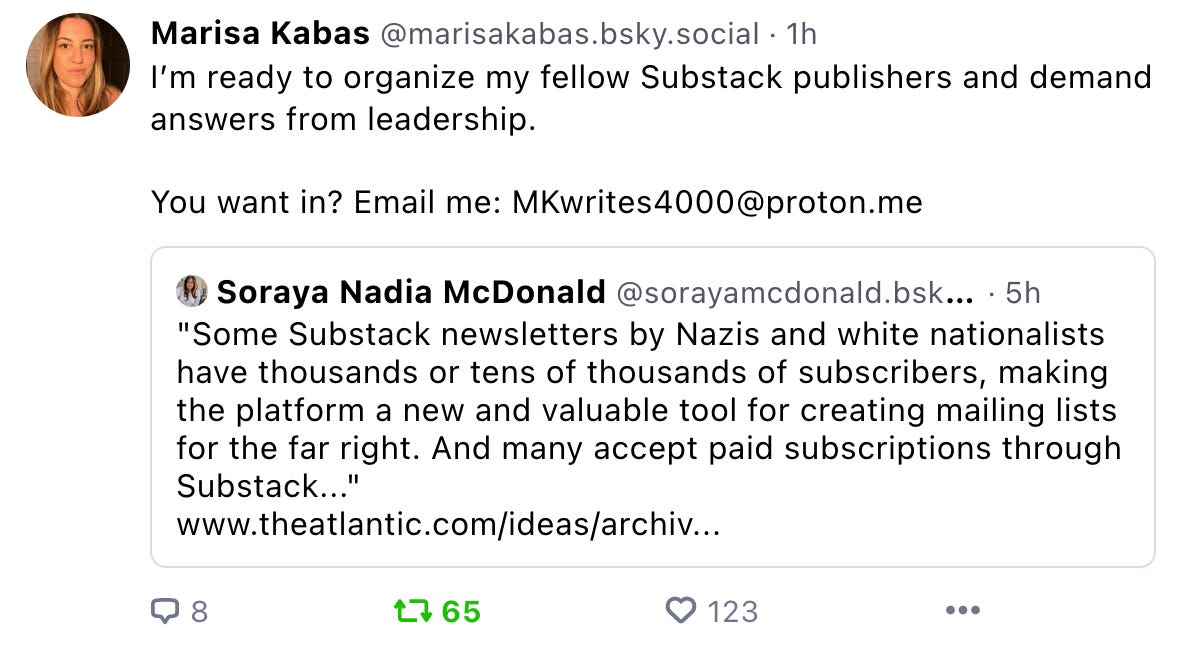
In my opinion, the choice is stark: if you’re a non-Nazi writer who objects to Substack making money from white supremacists (not to mention this site’s vast swathe of TERF writers and culture-war contrarians) you should make this extremely clear to the site founders, ideally in an organised, public way that doesn’t allow for individualised, targeted pushback. You could look to leave altogether, taking your subscribers and their revenue elsewhere: there are other subscription email providers that either have ideologically consistent free speech policies — allowing all legal speech, not carving out convenient exceptions for Nazis — or that don’t go out of their way to promote Nazis at all. Revolutionary stuff! Here are some alternatives:
Buttondown
Buttondown is not “free” in the way Substack is (Substack takes a big cut of your subscriptions) but they’re an inexpensive option for independent publishers. Also they seem like good sorts on social, without any pretence of “creating a new economic engine for culture.”1
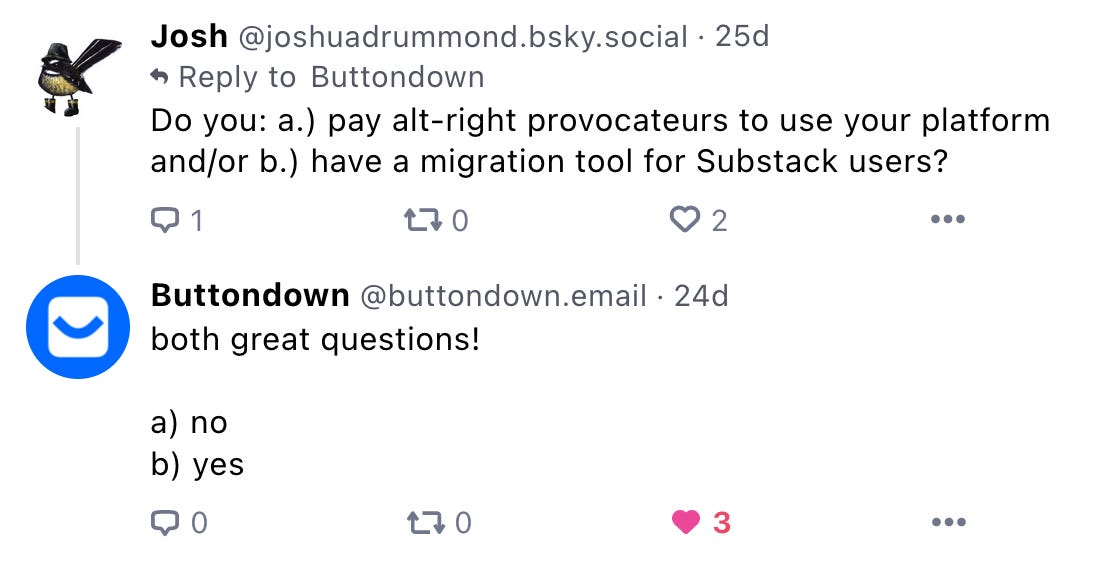
Here’s Buttondown’s Substack migration guide, including moving your paid subs.
Ghost
Ghost Pro is a very Substack-like experience for your newsletter and subscribers, with the option to self-host if you’re a tinkerer.
Here’s Ghost’s Substack migration guide, including moving your paid subs.
WordPress
WordPress.com’s Newsletter product now offers a paid email subscription option, including the ability to connect your existing Stripe account for paid subs.
There are other options out there too. For my part — as all my posts here and at The Cynic’s Guide To Self Improvement are free anyway — I will definitely be moving my newsletters to another platform if Substack doesn’t come up with a satisfactory response to their Nazi problem. It’s long overdue.

The Dark Present
Hi! I hope you enjoyed the sunshine in the Brighter Future. Unfortunately, today’s newsletter is a return to the Dark Present, with a timely reminder that everything is danged1 and it’s all economics’ fault.
Well, that’s not 100 percent correct: it’s lots of people’s fault, especially the governments who’ve refused to reign in the mad paper-clip machine of capitalism and have set civilisation on a course straight for the heart of the Sun, but neoliberal, orthodox economists deserve an outsize share of the blame for chaining the rest of us to the mast so all we can do is watch. And William Nordhaus is one of the crew — standing on the shoulders of giants like Milton Friedman and Friedrich Hayek — who’s done the most incalculable damage. When our kids ask us “Who killed the world?” we’ll be able to confidently answer “This guy.” The Intercept has the horrible details. Briefly paraphrased, the scoop is that Nordhaus’ theories that calculate the economic impacts of climate change are bollocks.
Nordhaus’s models tell us that at a temperature rise somewhere between 2.7 and 3.5 degrees Celsius, the global economy reaches “optimal” adaptation. What’s optimal in this scenario is that fossil fuels can continue to be burned late into the 21st century, powering economic growth, jobs, and innovation. Humanity, asserts Nordhaus, can adapt to such warming with modest infrastructure investments, gradual social change, and, in wealthy developed countries, little sacrifice. All the while, the world economy expands with the spewing of more carbon.
His models, it turns out, are fatally flawed, and a growing number of Nordhaus’s colleagues are repudiating his work.
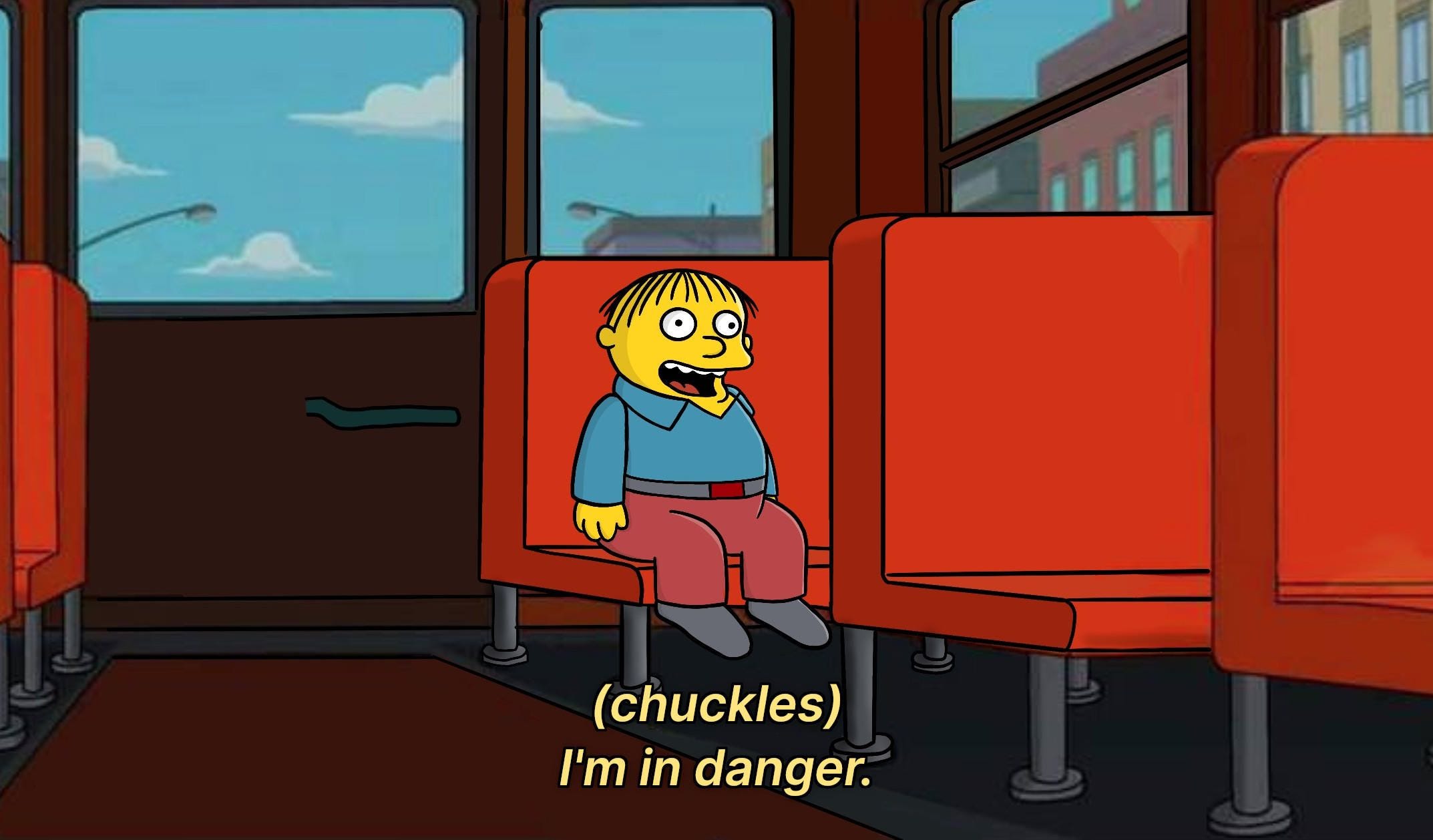
Yes, it turns out that Nordhaus’ work is pure copium, so attractive and addictive that it’s been mainlined by everyone from corporates to governments to the IPCC.
Johan Rockström, director of the Potsdam Institute for Climate Impact Research in Germany and a leading researcher on climate tipping points and “safe boundaries” for humanity, projects that in a 4 C warmer world, “it’s difficult to see how we could accommodate a billion people or even half of that.” Global population today stands at 7.6 billion, with 80 million people added every year.
By contrast, when Nordhaus looked at the effects of 6 C warming, he did not forecast horror. Instead, we should expect “damages” of between 8.5 percent and 12.5 percent of world GDP over the course of the 21st century.
He’d have gotten away with it too, if it wasn’t for those darn meddling laws of thermodynamics.
Start with your typical textbook for the dismal science — say, the definitive one by Paul Samuelson, co-written with Nordhaus, titled “Economics.” The book is considered “the standard-bearer” of “modern economics principles.” You’ll find in its pages a (…) simple, imperturbable closed system that’s also ludicrous, fantastical, a fairy tale. In the circular flow diagram of standard economics, nothing enters from the outside to keep it flowing, and nothing exits as a result of the flow. There are no resource inputs from the environment: no oil, coal, or natural gas, no minerals and metals, no water, soil, or food. There are no outputs into the ecosphere: no garbage, no pollution, no greenhouse gasses. That’s because in the circular flow diagram, there is no ecosphere, no environment. The economy is seen as a self-renewing, perpetual-motion merry-go-round set in a vacuum.
So how does it all work? Nordhaus’ theories are, of course, predicated on the fairy-tale of endless economic growth. Pry the lid off the voodoo equations of orthodox economics and you’ll find the same basic fallacy over and over again: line goes up.
In DICE, the effect of a warmed climate is measured solely as a percentage loss (or gain) in GDP. Growth of GDP is assumed to be “exogenously determined,” in the language of economics theory, meaning it will persist at a set rate over time regardless of climate shocks.
Like other orthodox economic fallacies such as the Phillips Curve — an illustration of the idea that having too much employment causes inflation, so having unemployment must necessarily un-cause it — Nordhaus’ DICE model is based on a fundamental misuse of mathematics:
The second of Nordhaus’s errors is the use of reductionist mathematical formulas. He employs something called a quadratic to calculate the relationship between rising temperatures and economic outcomes.
Economists are always doing this. They love nothing more than finding a concept that’s hideously complex and intrinsically non-linear and drawing crayon-like curves all over it. But wait, it gets much, much stupider.
The third of Nordhaus’s errors is related to similarly simplistic formulas. Nordhaus calculates GDP of a particular location as fundamentally related to the temperature of that place.
What — and I really must stress this — the dang. How does economics manage to elevate such abject, obvious idiocy to the pinnacle of the profession? The assertion is self-evidently untrue. GDP is not a function of your danging latitude. Nor is it a function of Nordhous’ next colossal mind-fart:
The fourth fatal error Nordhaus makes is the most farcical. In a 1991 paper that became a touchstone for all his later work, he assumed that, because 87 percent of GDP occurs in what he called “carefully controlled environments” — otherwise known as “indoors” — it will not be affected by climate.
It really has to be said again and again: dang economics.
Lest we forget, it’s also orthodox, neoliberal economics that has gifted us the currently-in-vogue method of dealing with climate change: carbon trading and emissions offsets. Let’s be clear: setting a price on carbon pollution is a good thing. But economists have, of course, poisoned the well of carbon pricing with carbon offsets: the idea that we can make up for burning carbon here by not burning carbon there, and that we can turn not-burning into licences to burn carbon. Factor in the idea of the world ploughing its valuable energy resources into mostly hypothetical technology to suck carbon out of the air and turn it into worthless dry ice and boom, you’ve got a plan to save civilisation — one that, typically for economics, makes no danging sense. Cory Doctorow has the goods:
[Carbon offsets allow] companies to make money by promising not to emit carbon that they would otherwise emit. The idea here is that creating a new asset class will unleash the incredible creativity of markets by harnessing the greed of elite sociopaths to the project of decarbonization, rather than to the prudence of democratically accountable lawmakers.
Carbon offsets have not worked: they have been plagued by absolutely foreseeable problems that have not lessened, despite repeated attempts to mitigate them.
For a break from all this, let’s look at journalist David Williams’ deep dive into what NZ’s local enemies of climate action have been up to lately. Ah, of course. They’ve been working to elect climate change deniers, minimisers, and delayers, in the form of the Act and National parties:
In the Taxpayers’ Union’s first press statement, in 2013, its founders described it as “a politically independent grassroots campaign to lower the tax burden on New Zealanders and reduce wasteful government spending”.
The independence claim has been repeatedly knocked.
In Dirty Politics, Hager wrote the Taxpayers’ Union “operates, in effect, as an arm’s-length ally of the National Party” and called it a “political tool”.
The following year, political scientist Bryce Edwards described the Taxpayers’ Union to the NZ Herald as “the Act Party in drag”.
A huge share of the blame for the Taxpayer’s Union’s success can be laid at the feet of news media, who essentially let political actors like the TPU and the Act party do their jobs for them. These groups function as press-release factories, churning out readymade news for conflict-hungry media, who are only too happy to both-sides climate-denying hysteria-bait about (for example) cycleways if it leads to them getting a few more clicks. They also make themselves permanently available, always ready to feed a juicy, conflict-loaded, nuance-free soundbite to the media maw. Witness the Spinoff’s live updates editor telling on himself as he complains that David Seymour won’t pick up the phone anymore:
During the Judith Collins years, he twisted this level of availability into becoming a de facto opposition leader, commonly leading coverage where the National Party leader would traditionally be found. If you couldn’t get a comment out of National, you’d get on the blower to Seymour and he’d give two or three well-communicated soundbites on just about anything.
Most journalists would ring him directly, or text him and expect a return phone call within minutes. On one occasion, he called me via a bluetooth bike helmet and I did the interview while he was cycling around his local electorate.
“Well-communicated soundbites!” I’m so sick of this stuff from journos. When will they learn that their job is not to hand out praise to politicians based on well they spin the issue du jour? That it’s not to give space to people — especially not powerful people — just because they’ll pick up the danging phone? Of course David Seymour’s not answering your calls: he’s in negotiations for his real job — attacking indigenous rights and sabotaging climate change action. What’s left of the (broadly) reputable Fourth Estate needs to figure out where it stands on climate change, ideally yesterday, and to stop platforming climate change deniers, delayers and minimisers like David Seymour and the Taxpayers Union without conspicuous disclaimers about what their policies and actions are and mean.
While I’m on the subject of lazy media, here’s another ghastly habit that can get in the bin and die: the uncritical repetition of political and economic myths. From yesterday’s Spinoff Bulletin newsletter, we get this:
By now, we all know the orthodox drumbeats: when employment levels are high, wages rise faster. People have more money to spend, so prices go up and so does inflation. When unemployment is high, the lack of money to spend means that inflation goes down. It is our old mate, the Phillips curve, conceived by New Zealander Bill Phillips. A consensus of bank economists ( paywalled, and is that the collective noun or just an accidentally clever allusion to it by Liam Dann?) is picking that the unemployment rate will have risen. Most are pinning that prediction on high levels of migration.
It’s nice that we seem to be gradually approaching the point where people might finally start saying the quiet part loud: unemployment is largely a political and fiscal choice, designed to keep wages (and inflation) suitably low; but what’s not being said is that simplistic economic concepts like the Phillips Curve are at best contested and at worst bunk. Even orthodox economists have had enough of the Phillips Curve: witness the ultra-neoliberal Cato Institute call it a “broken theory” and “a poor tool for policymaking.” So here’s another reminder, because you can never have enough: the broken idea behind raising interest rates is to make people lose their jobs and/or houses so inflation might come down.
The fact that inflation might happen not just because people have jobs, and could just as easily be attributed to supply constraints and massive corporate profiteering doesn’t seem to matter, least of all to media who are happy to keep repeating economic myths and making space for climate change creators.
On that note, and in good news for no-one but economists, there are signs that the Reserve Bank might finally be succeeding in engineering its longed-for recession:
The below, earlier issue of Hickey’s newsletter is well worth reading, not least because he shares some gobsmacking tidbits that should be being screamed from the rooftops by the rest of the media — like the fact that at current rates of growth (which successive Governments have both encouraged and done nothing to prepare for) NZ’s population will exceed 20 million by 2100.
Wednesday’s Chorus: An impossible trinityListen now (31 mins) | TL;DR: The key news in Aotearoa’s political economy today includes: National appears set to push councils to move their water assets off their balance sheets in a very similar way to Labour’s Three Waters plan, just without the co-governance and as much compulsion, but still with the flawed idea that somehow off-balance-sheet borrowing is actually better for taxpayers and ratepayers in the long run than facing up to the fact that higher taxes, charges and public debt are needed to fund fast population growth; The Kākā by Bernard Hickey
The Kākā by Bernard HickeyAnd then there’s this humdinger.
A Treasury analysis of the potential costs of the Crown having to buy emissions credits to meet its Paris agreement commitments was released in September and shows the cost to taxpayers could blow out to $25.948 billion by 2030, if as expected with current policies, there is a shortfall.
This is not included in the Crown Accounts as a contingent liability. If it was, a Government would be obliged to try to reduce it, or have to explain to taxpayers why they’re spending more on emissions credits overseas than it spends on health in a year.
The other option would be to renege on the Paris agreement, which ACT has advocated, and then see New Zealand’s FTA with Europe cancelled arbitrarily.
That’s where our “but David Seymour has perfectly-crafted soundbites and always picks up the phone!” attitude gets us: the neoliberal party looks to cost us billions of dollars in worthless “offsets” that we will be forced to buy for breaching our Paris commitments by not following the ETS, a climate policy advocated for and invented by neoliberals. Of course, none of that includes the staggering costs of not sufficiently adapting to or mitigating climate change, which are going to be much, much, much more. I’d say that we should just burn it all down, but that’s happening anyway. Happy days.
-
After getting a tip that my swearing was making my work hard to share I decided to change all incidences of the word that autocorrects to “duck” to “dang” or something similar. It’s perhaps a bit silly — I think it is OK to be angry about bad things, and that swearing is useful as punctuation among much else — but there’s no doubt that replacing swears makes the article much funnier. The original blue-tongued article will live on, in subscriber inboxes, and you can always mentally substitute “dang” for any other word you like. ↩
-

The Brighter Future
Saturday starts out sunny, so we catch the 9:05 rapid from Kirikiriroa to Paeroa. The plan: beach day. We make it to the station with time to spare, which isn’t too bad, as it was kind of a snap decision, and we’d only started biffing beach things into bags half an hour before getting on our e-bikes.
I sit with my laptop, tapping out a piece. This piece, in fact. They wanted some kind of retrospective on the last decade, the remarkable story of how Aotearoa had so quickly become a global leader on climate change, and I figured framing the story through our beach trip made sense. That, or I was just a bit desperate about the deadline and needed a quick and dirty device. While I fret about story framing, Leo lapses back to an earlier stage of childhood and gets his mum to play Eye Spy. I get a bit lost in my work and when Louise gives me a meaningful nudge I realise it’s been a solid 15 minutes. Nearly in Paeroa! I take Leo for a wander down the train, but it’s the cafe car he’s most interested in. I buy a pie for Leo, and can’t resist my own mince and cheese: the railway pies are legendary, and I tell myself that the fact that Leo’s is vegetarian makes us square. “Meat is a treat,” I say, silently.
Coming back from the cafe car, the view outside gets a bit grim. Flashing past is the pathway left by Cyclone Cassandra, which rode a plume of warm air inland, through the Hauraki Plains all the way south to the King Country. Entire shelter-belts felled, sheds blown across the landscape, flash floods ripping through bridges. The rail line was down for nearly a week while they checked the viaducts, but all the strengthening and triple-redundant engineering work had, well, worked. And I can see the Climate Corps have been busy: mobile sawmills have carved up the felled trees for timber and mulch, buildings and bridges are repaired, and there are new wetland restorations and riparian plantings started everywhere.
It feels like a metaphor for a decade ago: out of the wreckage and ruin, something new, something good. First, the Greens became the largest party on the Left, then — after the Chaos Coalition fractured, and the snap election — the new Green and Te Pāti Māori government, with confidence and supply from the Labour remnant.
Obviously, the rapid rail didn’t appear overnight. That took a lot of work and it’s really only in the last couple of years that it’s properly kicked off nationwide. But a lot of things got better pretty much straight away. It turned out that the Government had plenty to work with once it decided to take the 1940s approach and got back some of the money that had been hoarded, stolen and secreted away by sociopaths. Wealth taxes for the 1 percent, excess profit taxes on the mega-corporates, Robin Hood taxes on the banks: the commentators screamed and screamed but, once it became clear that more than 95 percent of normal people weren’t losing out but benefiting, the electorate were more than happy to see it continue. The first big improvements were in the health system, with free dental straight off the bat. I had three gaps in my teeth and a mutilated jaw from the bad old days when the only publicly-funded dental care you could get as an adult was an extraction; within a year, I had three shiny new artificial teeth. Transport was another quick win: the new government bought (and converted) as many e-buses as they could and pretty soon you could get an express bus from anywhere to somewhere else. For free. “Communism!” cried the Opposition and the commentariat, leading the new Minister for Transport to quip, “Transport for each according to their needs.” All the politics nerds thought it was funny. I thought it was funny. It probably wasn’t that funny.
And then the rail build started in earnest. We stopped using consultants from the New Zealand private sector, not just because they charged millions to do nothing, but because it turned out none of them had the slightest idea of how to build railways. Instead, we looked to Switzerland, and Japan: two nations with similarly challenging geography and notable rail-building expertise. We brought their best rail people over and said “how soon could you get this running?”
Quite soon, as it turned out, with enough people-power — and we had that in spades.
The Green Jobs Guarantee made the neoliberal economists absolutely lose their shit. It was a full employment scheme, paying a living wage, across a huge range of projects. Railways, native forestry, pest control, managed retreat, central-city densification, teardowns and rebuilds and renovations of entire leaky districts, climate-proofing coastlines with beach and dune restoration, weirs and seawalls and dykes. Heat pumps, insulation, double-glazing, air filtration, for any house that needed it. Riparian planting, eco-farm conversions, digging up lawns and planting food forests. Re-wilding, rangering, ecosystem management, kaitiakitanga guardianship, the big Crown Landback mana whenua schemes. Huge budgets for science, for the Department of Conservation, research institutes, universities, for throw-shit-at-the-wall, see-what-sticks solutions. A new Ministry of Green Works, the Climate Corps, hundreds of local organisations. Suddenly, everyone who wanted a climate job — a job that paid! — could have one.
Lots of people did. Cubicle drones quit in droves. Long-neglected regional towns filled up with hugely diverse mobile populations, all working on climate projects. Very little of it was based on what economists said was good for the economy (which, often, turned out to be what was good for the elite). It was instead based on a number of “heterodox” economic theories, which — when it really came down to it — were mostly about values. Needs became recognised as rights: to food, water, a home, community, care. Everything was organised around providing the essentials for everyone, and doing the needful to mitigate and adapt to climate change. The economy would take care of itself, just as it had for the thousands of years before economists had created the concept.
It was madness, the neolibs said. If everyone had enough money in addition to housing, food and job security, disaster would strike. They predicted exponential inflation. “A loaf of bread will cost ten million New Zealand dollars within a year!” screeched one prominent commentator. He bet his job on it. When it didn’t happen, he refused to quit, was fired, and moved to a houseboat. The last anyone heard of him he was arguing with a hydroplane full of bemused tourists that his boat was a sovereign nation and that they were infringing on his borders.
As time went on, the bigger projects started to come online. Once the electricity generator-retailers’ mandate changed from “make money” to “decarbonise” things really got underway. The hydro-powered mega-battery at Lake Onslow, plus a rapid rollout of renewables and rooftop solar took fossil fuels out of the grid. At the same time, the rapid rail network was being built. The trickiest part was getting new, bidirectional heavy gauge rail laid across the new overland routes, but helpfully, a lot of the work was already done. The Swiss and Japanese project leaders were impressed. Those scrappy Kiwi builders blasting through rock and scraping away with hand tools had done an amazing job for the times, and now we had modern engineering techniques to build on the solid foundation they’d left.
Back to our seats, as we pull into Paeroa station. Louise eyes the crumbs on Leo’s tee. I make innocent sounds, and offer to hang out with him during the Kaimai leg. She snorts with laughter. “It’s all scenic. Hardly a chore!” But when we switch to the light train from Paeroa to Waihi — a few modern trams strung together, really — she picks up her book and I take Leo to the packed viewing car.
The Kaimais are always a sight. The high gorge walls, the dramatic twists and turns of the river; even on a grey day it’s remarkable. But when it’s bright out, wow. The sharp blue sky cutting against the myriad greens of the forests, the train sliding almost silently down the parkway; it puts everyone in a wide-eyed mood. It helps that the train is packed with families and little kids. As we wind through the gorge parkways and trundle over the viaducts the kids wave at the hikers and day-walkers, and fizz when they wave back. Then they try to hold their breath through the tunnel; you could see them turning red in the dim light. I’d thought Leo was too old for that at 14 — he can be such a serious kid. But as we emerge from the tunnel I hear him gasp, but quietly, so I won’t clock what he’s been up to.
The light rail line terminates in Waihi, but let’s be honest: no-one wants to hang out in Waihi on a day like today. We grab the free e-bus out to Waihi Beach. We could have waited for the next one for a bit more room, but I want to get to the beach before the tide turns and the waves get sloppy. Leo offers his mum a seat, which is good of him. I make a mental note that she owes me some sitting-and-writing time on the trip back.
From the station in Waihi Beach we walk to the beachfront, and it’s a good thing it’s only a few hundred metres. It’s hot. It isn’t noon yet but it’s already 32 degrees in the shade, with high heat and humidity warnings in effect for later in the day. Luckily, it’s also windy, and that offsets it a bit. I’m slightly disappointed to see that the waves have got a bit blown out by the gusty offshore breeze.
Leo checks out the surf report. “It’s cranking at Whiritoa,” he says. I discuss it with Lou and we decide to bike. There are plenty of e-bikes at the kiosk so we get one each and set off.
In the olden days of a decade and a bit ago, it’d have been way too much of a mission. It’s 26 k’s from Waihi Beach to Whiritoa and there are plenty of hills. Back then, you’d have had to put up with bumper-to-bumper traffic, and cars passing you way too close, pedalling hard the whole way. Only the hardened warriors of the weekend lycra brigade would have chanced it. But now? All e-bikes and buses. We join a peloton, with entire families out for the ride, cruising along at a brisk 50 clicks. The few cars that go past — often providing for people with disabilities, local farmers, kaitiaki rangers, and the like — give us a wide berth, tooting. We wave back.
Whiritoa is hot, too. The electronically-assisted ride kept us cool but as soon as we hand the bikes in to the kiosk we can feel the heat walloping up from the asphalt: the old town’s roads are scheduled for greening and shade-tree transplants but it hasn’t happened yet. Even with a fully mobilised climate corps, there’s so much to do! Lou holes up in a heat shelter with a playground, cafe and aircon, and Leo and I hire boards and get amongst the waves. In one of those weird mixed blessings of our new Changed Climate era, the ocean is slightly cooler than normal for this time of year — a marine heatwave has been chased off by a cell of cool water from the Southern Ocean, which has also blessed us with swell.
The paddle out is rough. Today’s wave at Whitiora is a fat right, clean but heavy. There isn’t much in the way of a rip to ride out, and I feel all my 51 years once we’re out beyond the breakers. Leo crushes it; even though he’s slim for 14, constant swimming and frequent surf missions have built him up and he’s already caught one by the time I reach him.
We are out there for the next couple of hours, and they are bliss. In the water, it all recedes, like the waves, like the tides. The heatwaves, the heat domes, the wet-bulbs, the fires and the storms. You forget the mass die-offs, the coral catastrophe, the wars and the water shortages and every other awful artefact of the globally-heated Anthropocene. The worst of times, the best of times. There have always been terrible things in the world; what is different is now we see them, we face them, we deal with them, we do the needful.
Sometimes the needful is surfing.
Big wave coming. I paddle hard, pop up at the crest, turn, duck, dig in. Barrel! It lasts half a second, or maybe an eternity, the grin on my face reflected and frozen in the inner surface of the breaking wave like ice. Then the lip catches me and I go over the falls. Turned, tumbled, dumped and held. The surf pounds in my ears and I open my eyes. I can’t see a thing but I’m not winded — whew. My leg-rope yanks hard on my ankle and then slackens. It’s snapped. Somewhere up there, my board is tombstoning in the foam. I hold my breath and dig my hands in the sand for the next wave and pop up when things look less white.
Leo is waiting. Smart kid, he’s figured out exactly where I’ll come up. “Dad! You all right?”
I’m breathing heavy. Old man. “I’m good!” I say. “Just a hold-down. Most quiet time to myself I’ve had in years.”
Leo punches me in the arm, but not hard enough to deaden it. I pull myself onto his board and paddle out beyond the breakers again as he swims next to me. When my breath is back to normal we catch the waves back in to shore. A bloke with a German Shepherd has snaffled my hire board out of the surf and the dog is losing its mind; it’s never found a stick this big before.
We take the boards back to the woman at the hire stand next to the heat-shelter, and I get to pay extra for the snapped leggie. Leo spots a girl he knows from his statistics class — he’s nearly at uni level, kid is just ridiculously good at numbers — and they’re off chatting. I towel off, shirt on, catch up with Louise who’s been watching us through a zoom lens from the cafe.
“That was a big one,” she says.
“The wave or the wipe-out?”
“The wipe-out,” she says. “The wave wouldn’t have cracked three feet.” She hugs me. “You were down for a long time. And you lost your board.”
“Leo was there,” I say. I think about how weird that is. Kids are so strange in their teens. One minute you’re playing Eye-Spy with them on the train and they’re begging you to spot them a railway pie because they spent all their pocket money, and the next they’re a lean surfer dude ready to haul you out of the waves and paddle you back to the beach. And both these different things are true at the exact same time.
The country has grown up too. People like to stay in Aotearoa now, or if they leave for an OE, they actually come back. Turns out it was the chronically low-wage economy — kept that way on purpose, for decades, to keep the inflation boogeyman at bay — and lack of any real opportunity that was driving people away. Who knew! In hindsight, it’s all a lot more obvious. No young person wants to stick around when the only way up is to become the small-time feudal lord of a dozen decaying houses, and hope you can ride the market out. Boring! Only the dullest, least imaginative people want to do stuff like that. Most people want to do interesting things, and for those things to be meaningful. In other words, they want to work. It’s just that before, a lot of the jobs were bullshit.
They’re not now. The work is urgent, important, endlessly engaging. Everywhere you go, there’s a climate project, or a paid training opportunity. 75 year olds are bailing on retirement and getting university degrees in climate mitigation. Train conductor is something kids grow up wanting to be for the first time since, perhaps, the 1950s. And the world’s smartest people are pouring into Aotearoa to do climate work, because we’re finally funding it to the degree the emergency demands. When you do want or need to take a break from the world of work, the income guarantee is there to catch you, and there are no shortages of stipends and grants to encourage you to make something meaningful in your spare time. I’ve done it; I took a half-dozen years out to be full-time dad to Leo and paint pictures while Louise got really into collecting literary awards. We’ve swapped again now, and I’m back punching keyboards for climate. Now that there are dozens of independent local outlets running off carefully ring-fenced public funding — I’d like to see anyone in Government try and tell them what to publish, by law they’d practically have to bite their own heads off — it’s a lot easier to make a crust as a scribbler. In the past, we seemed to think that that job precarity would make people work harder. Of course, that was wrong: another one of those obvious-in-hindsight things. Productivity, whatever that is, comes of letting people do what they like.
Louise and I watch Leo chat to his friend. She takes my hand and I hold it. It’s not clear what they’re talking about: from the gestures, it could be about seeing a really big fish or sketching out a box-and-whisker graph in the air. He’s not sure what he wants to do yet; one day it’s Zeppelin pilot, another it’s ecologist like his uncle, another it’s statistician, which was probably my biggest “are you really my son?” moment so far. Lately he’s interested in geoengineering, pumping meltwater out from under the big Antarctic glaciers and up onto the ice sheets to stop them sliding into the ocean. It’s funny to think he might actually want to stay in the country, though. When we were his age, all anyone wanted to do was leave. Anything to go somewhere real, to get out from under a stultifying culture created by and for frightened old white people, to escape careers that seemed to amount to a choice between real estate or cows, cows, cows.
It all seems like a dream, a bad dream we didn’t know how to wake up from. There’s so much that’s harder now, so much that’s different. The world I grew up in is gone, and sometimes the sheer scale of everything we’ve lost and will lose to climate change feels impossible, a weight crushing all the breath out of me. But so many other things are better now, and that feels like magic. Just like in fairy tales and fiction, it turns out most of what we had to do was believe that it was possible.
It’s the hottest part of the day. We’ll be here for a while yet, before taking the bus back to Waihi and catching the train home. Louise has her book, Leo has his friend and animated chatter about — I think I catch a sentence fragment — polynomial regressions, whatever those are. All is as right in our world as it possibly can be, and yet there’s so much more work to do.
I get my laptop out of my bag and get back to it.
All my writing here is free. If you like what I’m up to, I ask you to share it.
This piece is intended as the chaser to a depressing shot. Some people told me that The Party That Can’t and The Party That Won’t was good, but very grim to read, and I wanted to write something that was the opposite of grim. So I wrote this. It’s a science fiction story, or at least I think it is. It’s fiction, and there is some science. And obviously there might be some fantasy elements. I don’t know if it’s physically possible to build a rapid rail network in ten years (although I suspect that with enough workers and funding it would be.) All that said, I still want you to take it entirely seriously. What could we accomplish, if we really put our minds to it, and we elected a government that both saw what was needful and (almost unprecedentedly) actually did it? And what would your story be, if we did such a momentous, important thing? That’s a take I’d love to hear in the comments. What does the Brighter Future — a term that I am intentionally lifting and shifting from the context of John Key’s National government — mean for you?

The Party That Can’t And The Party That Won’t
Approximately every three years I indulge in a bit of political punditry, which is about as much as I can stand. It’s nearly that time again, which is my opportunity to do something pundits almost never do: see what they got right and wrong.
Here’s what I wrote after the last election, for the much-missed Public Address:
But if I was to write my own hot take, based entirely on the undeniable fact of a left-wing election landslide, post-hoc anecdote and my own keen understanding of “the vibe,” it would run like this:
Labour won because they demonstrated competence. The end.
You can read the rest if you want but that really is the crux of the argument, and I stand by it. At the beginning, the Labour-led government handled Covid-19 well, especially compared to practically every other country on Earth. The proof is out there: unlike many nations that suffered enormous excess mortality, New Zealand experienced the opposite. The Government saw what was needful, and they did it. Numerous, perhaps inevitable, flubs aside — and despite endless attacks from the political Right and their mouthpieces in the media who were incapable of comprehending disruption to their precious status quo — the public saw it, and Labour were rewarded for it with the only single-party majority government ever formed under our brand of MMP.
But that’s not where the article ends. Foolishly, I let myself be optimistic. Perhaps Covid was just the start: perhaps seeing that doing the right and needful thing could also be extremely popular with the electorate would set Labour up to do the urgent work on our neglected “nuclear-free moment,” climate change — and on health, and housing, and the cost of living, and every other facet of New Zealand’s polycrisis.
People who vote for an left-wing party with explicitly left-wing principles should be rewarded with left-wing policies.
Voters delivered the Left their election victory based on their rediscovery of the power of government to aid society; and to stay in power, they’ll need to continue wielding it.
And that, of course, did not happen. Boy did it ever not happen. Now, almost three years later, we are faced with a return to a ruined status quo, and a seeming choice between two broken political alternatives:
The Party That Can’t and the Party That Won’t
Let’s get some definitions out of the way. When I say “can’t” or “won’t,” I am talking about what we ostensibly elect political parties for: to do the needful. And for the avoidance of confusion, the Party That Can’t are Labour. The Party That Won’t are National. We’ll get to them, but Labour are the government so they go first.
The Party That Can’t
The Covid-19 pandemic was still raging1 when Labour began to regress to its mean: a milquetoast, ineffective, appeasing, ever-so-slightly blunted version of the neoliberal status quo designed to appeal to “centrists” and in fact intolerable to anyone but the most determined party apparatchiks. Modern Labour’s can-kicking methodology is wearingly familiar to anyone who watches New Zealand politics for sufficient time:
- Commission a review on a really obvious problem, often carefully adjusting the terms of reference so no truly transformative measures are possible
- Do nothing while the review takes ages to report back and spends a bunch of money
- Seriously consider the review’s sensible, often restrained, recommendations. Put out a press release, and
- Do nothing
- Repeat until all your ministers have done something stupid and the electorate hates you.
A list of all the reviews Labour has commissioned would be too long to write up (and, inconveniently for journalists but conveniently for Labour, there appears to be no central repository of them) but here are some highlights: they did almost nothing about the electoral review that recommended a voting age of 16, they did almost nothing about the welfare working group report that recommended sweeping changes to our cruel welfare system, they did almost nothing about the tax working group that recommended a raft of desperately-needed changes, even with a capital gains tax specifically excluded from their terms of reference, and they did nothing meaningful about the Commerce Commission “market studies” into the grocery sector, retail fuel prices, and residential building supplies. The results of flagship policies like Kiwibuild, an emissions scheme for farmers, an Auckland Harbour bridge crossing for the vast majority of things that aren’t cars, and light rail for Auckland are, in order: fucked it up, fucked it up by appealing to an industry who hates them, dithered to the point of absurdity before fucking it up, and didn’t even fucking start despite spending $44 million on consultants. Then there’s the things they’ve ruled out: asinine “Captain’s calls” on capital gains taxes and other issues that are popular with the electorate, while committing political seppuku with widely-loathed measures like petrol taxes. Labour, under Jacinda Ardern, failed to back cannabis reform so sensible that Canadians were into it. Consequently, the (needless) referendum was lost by a hair after opponents of reform were allowed to lie endlessly about the proposed law, with no correction from the Prime Minister or her Government. New Zealand now rejoices in an absurd situation where sufferers of chronic illness can choose to be euthanised for free but have to pay through the nose for medicinal cannabis.
Labour also scored remarkable own goals by begging for the support of teacher and nurse unions at election time, then cynically denying overdue pay rises, leading to protracted strikes when school students and patients could least afford them. Even the reform Labour did manage to get off the ground — including centralizations of long-neglected healthcare (Te Whatu Ora) and water services (Water Services Reform Programme, née Three Waters) — were not explained or promoted with any kind of due care, which enabled right-wing astro-turfers like the Taxpayers Union to spread misinformation, seeding the rise of racist groups like Stop Co-Governance. To this day, you cannot drive past more than a couple of dozen houses in my town before encountering a Taxpayers Union-provided Stop! 3 Waters2 sign. What’s more, this reform has come so late that it’s far from entrenched, making it effortless for an all-but-inevitable right-wing government to repeal.
They didn’t get everything wrong. What’s most infuriating about what they screwed up is what they got right. It bears repeating: New Zealand’s Covid response was unparalleled in its excellence. Covid is now one of New Zealand’s leading causes of death, having killed over 3000 people and with 1000 more set to die of it by the end of 2023, but research shows that an astonishing 20,000 lives were saved by our response. Twenty thousand priceless people, alive, who — if they’d been in nearly any other country, or if New Zealand had followed the ignorant urging of right-wing politicians and opinionist media — would almost certainly have been killed. This is heroic. The triumph should be shouted from the rooftops; it should go down in history. If there’s any justice, it will.
There were other wins. Increasing the minimum wage was consequential for the working poor, who would never see the Right’s proposed tax cuts for higher earners. Labour enabled Kainga Ora to build a lot of public housing.3 Doubling sick leave entitlements from a paltry 5 to a slightly better 10 days was not only humanitarian common sense but good for the economy. The wave of fascist anti-LGBT sentiment experienced by many countries seems to have broken before hitting New Zealand, with the result that Labour managed to pass laws banning harmful conversion therapy and reducing barriers to gender self-identification. Labour also delivered much-needed abortion law reform, removing abortion from the Crimes Act.
But you can — and I will — argue that much of this, excepting the Covid response, amounts to fiddling on the margins of what’s possible, and doesn’t even approach doing the needful to New Zealand’s current polycrises: health system collapse, housing, education, transport, the cost of living, and most of all, climate change. What’s more, our Covid response has declined from world-beating to practically non-existent. Expert urgings to implement non-intrusive, cost-effective measures to prevent illness and death from not just Covid but other respiratory illnesses — primarily by improving ventilation in buildings and mandating masking in healthcare settings — have, characteristically, been ignored or fumbled.
Naturally, New Zealanders are deserting this festival of incompetence in droves. Which leads us to:
The Party That Won’t
“Labour,” the logic seems to go, “has proved incapable at tackling the systemic issues that beset New Zealand. Therefore, let’s elect… the other guy!”
This mindset is encouraged by the political media, many of whom love nothing more than promoting the perception of a two horse race. Labour are (often justifiably) ripped down, just as National (utterly unjustifiably) are lifted up. This is far from universal. The one great law governing media is the promotion of conflict, and when conflict can be juiced from telling the truth about National’s blunders, the news will Do Its Duty. We see this in the treatment of National’s unworkable tax plans and fantastical costings, which — while first uncritically hailed by Newshub’s Jenna Lynch as a “masterclass of political marketing” — have now become a millstone around leader Christopher Luxon’s neck, sparking fiery interviews and scorching op-eds. It’s funny because Luxon, the seven-house-owning living avatar of the landlord class whose self-styling can best be described as “sentient real-estate ad,” has no idea what his numbers are or what to do with tough questioning, but it’s sobering, because this guy will in all likelihood be the next prime minister. The overall, inescapable impression from the polls and media narratives (sometimes unstated, sometimes overt) is that these parties are much the same; that Labour are just National-lite, and the electorate might as well roll the dice on getting a more competent version.
In some ways this is true. In others, it’s extremely not. If Labour are a racecar that did one heroic lap before stalling out, National and Act4 are the same car, careening wildly in reverse. Labour has failed to enact much-needed climate action, but National will reverse some of Labour’s paltry gains, and reopen offshore oil and gas exploration. At the time of writing, Queenstown has spent weeks collectively vomiting and there are sinkholes eating Auckland because our water and sewage infrastructure is wrecked, which Three Waters is an attempt to finally fix; National have promised to repeal Three Waters and gut Labour’s resource management reforms. In a cost of living crisis Labour has, at long last, enacted worker protections; National will immediately destroy them, bringing back punitive, unfair 90 day trials. Thanks largely to the Greens, Labour have given renters some protections; National will introduce no-cause evictions. And — perhaps most damningly — while Labour has often failed the poor and those who rely on benefits to live, National has sworn to be vicious to them. It’s also worth considering what happened last time National ran the Government: the result was a litany of scandals including the Dirty Politics revelations that the Prime Minister’s office was running a PR hit squad, and an exacerbation of crises including housing, homelessness and health.
National also built some roads. Often economically unjustifiable, climate-ruinous roads. About the only thing The Party That Won’t will build is roads.
As anyone can see, National and Labour are not the same. And yet. As leaders Chris and Chris themselves admitted during their first debate, there are inescapable similarities — and the reasons that National won’t do the needful and that Labour can’t amount to the same thing.
There Is No Alternative
Most years, the great neoliberal institutions of the world pool their titanic minds and gravely declare New Zealand the best country in the world. In 2020, the World Bank dubbed us the best country for “doing business.” The Cato Institute, a US-based free-market think-tank, ranks us top among the nations for “economic and human freedom.” In 2020 we were first, in 2021 and 2022 we were a close second, tucked behind another mountainous bankers’ paradise: Switzerland.5
Time for another definition, because “neoliberalism” can easily be a woolly descriptor for “things I don’t like.” For the purposes of this article I am using Naomi Klein’s definition, from This Changes Everything: neoliberalism is capitalism unbridled, featuring “privatization of the public sphere, deregulation of the corporate sector, and the lowering of income and corporate taxes, paid for with cuts to public spending.”
And this matches New Zealand perfectly. This country is so neoliberal it’s forgotten how neoliberal it is. Thanks largely to former Labour Finance Minister (and later Act party founder) Roger Douglas, and followed by National Finance Minister Ruth Richardson, New Zealand pioneered the art of making inflation (when everything becomes more expensive) go away by raising interest rates (which makes everything more expensive), and intentionally creating recessions and making people unemployed to fix the economy.
I fear that last bit might have escaped attention due to how mind-boggling it is, so it bears repeating: unemployment is intentional. Our low wage economy is kept that way, on purpose, lest we awaken the inflation boogeyman.
You could be forgiven for thinking that unemployment is a bug in the economy, as opposed to a feature. After all, governments boast about low unemployment rates, and opposition politicians use high unemployment as a cudgel. What’s more, people without jobs are demonised. Unemployment, politicians say, is indicative of laziness, of an improper lack of personal responsibility. Beneficiaries — unemployed people who require Government support — are frequently characterised as bludgers, or more recently, “bottom feeding” by the likes of National party leader Chris Luxon.
Nothing could be further from the truth. Every neoliberalised economy harbours the same heart of darkness. Somehow, it’s still not common knowledge that the economy is set up to make sure that around five percent of the population will not have jobs. But sometimes this part of our societal setup, normally kept quiet, gets said nice and loud.
“50,000 people may need to lose their jobs to bring inflation under control” said a Stuff.co.nz headline on September 23, 2022. Economists at the Financial Services Council Conference — a kind of festival of boredom — said “unemployment might have to rise from 3.3 percent to five percent before inflation was back within the central bank’s target range.” In other words, the best thing for the economy is for more lives to be ruined by lack of work.
This is the status quo we’ve lived with for almost four decades, and Labour and National’s attitude can perhaps best be summed up by this timeless cartoon:
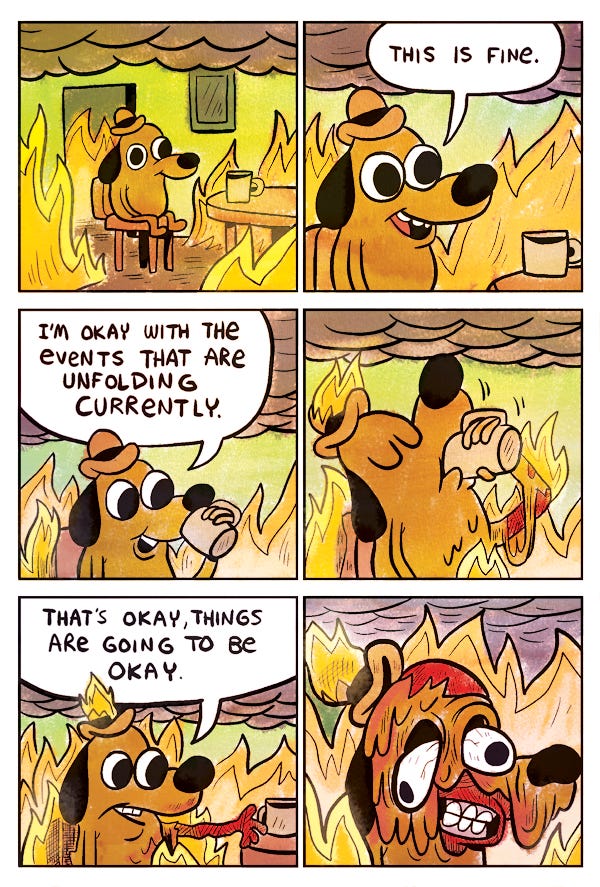
Labour is, perhaps, a bit less fine with it, which is why the Reserve Bank Act 2021 requires our monetary policy overlords to consider the “maximum sustainable employment rate” before deciding that the employment rate is unsustainable and hiking interest rates anyway. National has promised to remove even this weak provision, the better to sacrifice people’s jobs on the altar of low inflation.
Of course, they do all this while promising to crack down on and sanction beneficiaries who don’t get the jobs that their own policies are taking away. There’s never been a more literal case of heads they win, tails you lose. But Labour do it too. Both major parties are steeped in the same economic orthodoxy that Margaret Thatcher told the world there was “no alternative” to — and, over time, the bars of our economic prison have become invisible. The Party That Can’t and the Party That Won’t are equally addicted to the neoliberal status quo, and this frames every possible policy choice and political calculus. This, in addition to common cowardice and basic ineptitude, is the reason we cannot have nice (or needful) things.
Can we face down the nuclear-free moment and do something about climate change? No, we cannot, because the neoliberals at Treasury will tell us that it is too expensive, without accounting for the staggering opportunity cost of not fixing it. Can we implement a wealth tax or a capital gains tax, both of which are popular with the electorate? No, because the
Business RoundtableNew Zealand Initiative will summon its ultra-neoliberal economists and home-grown political editors to haunt us with spooky tales of our most bloated parasites perhaps leaving the country (oh, no!). Can we reign in some of the world’s most profitable banks, fix the broken property market, or tax the mega-profits of our supermarkets, puffed up like ticks from greedflation?6 No, no, and no. Even Labour’s ridiculous overspend on contractors and non-start on light rail is par for the neoliberal course; with public services hollowed out from years of neglect and cost-cutting, and without a Ministry of Works to do works, Labour are forced to go to the private sector, who have fast figured out that taking money and not doing things is much more profitable than doing them. Our neoliberal consensus forbids us from doing the needful with either borrowed or taxed money; instead we must always work towards Surplus, labouring under the fiction that a sovereign government that can literally make up money to pay for whatever it likes is somehow like a household’s finances. We are so neoliberal, so mired in our essential brokenness, that some of the most neoliberal institutions on Earth are begging us to be a bit less munted. We have the OG Vampire Squids, Goldman Sachs, warning National that their proposed tax cutswill require more poor people to be sacrificedare inflationary. We’ve got the International Monetary Fund, loan sharks to Global South economies, telling us to hurry up with the goddamn capital gains tax already.I feel almost sorry for Labour, because they’ve been such good neoliberals. Every time they were chastised for not doing enough, they did less. They tilted to the centre, and their poll numbers plummeted. Surprised, they did it again, and again, and again. Meanwhile, their remaining cheerleaders on social media rage every time someone in National dares cast aspersions on Labour’s economic record, because against many odds (including the ones created on purpose by the Reserve Bank) they have managed to keep GDP positive and public debt low (relative to most other developed nations.) No matter how much misery or fury the electorate felt, they could point to a graph and say “but see? Line goes up!” Labour’s tiny but endlessly vocal army of desperate apparatchiks seem to miss the point that people can’t eat graphs and that an ongoing ministerial clown-show kind of overshadows the economy being a bit better than most of the rest of the OECD. In fact, it’s almost like — whether they realise it or not — most normal people don’t actually care about the economic indicators that we’re told endlessly about, by politicians and political commentators.
Instead, it seems we care about having competent leaders who might do what’s needful.
Labour have proved incompetent, so the swing voters of the electorate have pinned their hopes on National. These voters hope the Right will trump all current evidence and previous trends and turn out to be competent. They won’t. The Party That Won’t — plus the neoliberal cultists of Act and the anti-science lunatics of New Zealand First — will be cruel, and their neoliberal enthusiasms will leave us even less prepared for the fresh horrors our warmed climate has in store for us.
The one saving grace and remaining hope for meaningful climate action is that, of course, you can vote for someone else.
Thanks for reading. This post, like all my work here at the Bad Newsletter (and my other newsletter, The Cynic’s Guide To Self Improvement) is free. You can pay me back by sharing it. In fact, I’d love you to not just share but make use of this post: take what I’ve said and read it out on a video, add in all the other damning facts I’ve either forgotten to include or didn’t have room for; quote it, turn it into Tik-Toks.
Thank you for reading The Bad News Letter. This post is public so please share it.
If you want to support me to make more of this sort of thing, please consider a paid or free subscription.
CORRECTION: A previous version of this post had a footnote that stated that Act policies include “include a tax hike on poor New Zealanders earning less than $70,000 a year.” This, as far as I can tell, was incorrect. The corrected statement is “include a tax hike on the 50+ percent of New Zealand earners who make less than $48,000 per year.”
-
Especially for the most vulnerable, the pandemic rages still, and it may never truly stop. ↩
-
Sic. ↩
-
Not enough, but still. ↩
-
This is Act as led by David Seymour: a sniggering, snivelling, hateful gremlin who, after a career spent as a right-wing lobbyist, now enjoys a seemingly permanent easy ride in the media despite the slow-dawning realisation his party list has accrued more cookers than a kichenware store. Seymour leads an ostensibly classical liberal party whose only ideological consistency is a committent to viciousness so profound that they have been repudiated by their founder; whose signature policies include a include a tax hike on the 50+ percent of New Zealand earners who make less than $48,000 per year and not allowing owners to do what they like with their own property. ↩
-
Hilariously, Switzerland has both real-estate capital gains and wealth taxes. ↩
-
Before this report came out BusinessNZ commissioned one that concluded that “greedflation” wasn’t a thing in New Zealand, which is a bit like hearing foxes say that the henhouse is fine actually and in fact could do with more chickens and fewer doors. ↩
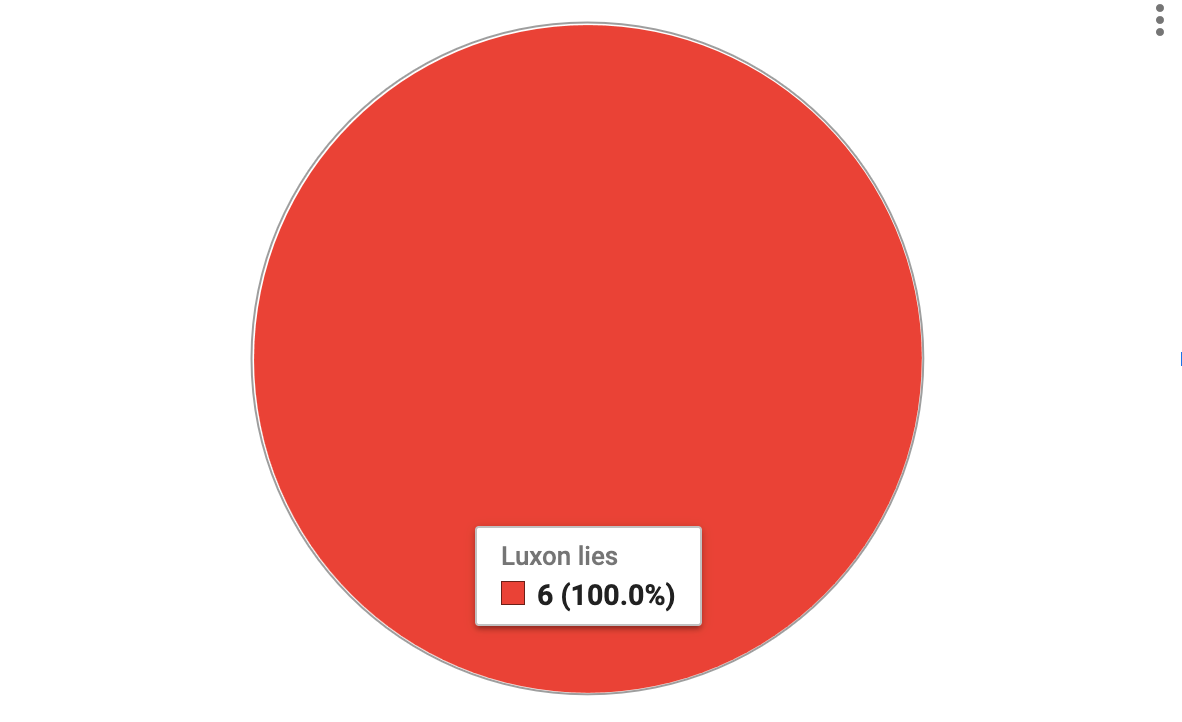
The Biggest Liar
Political debates are shit.
Not only do they not follow the rules of actual debates, they’re a boring yet simultaneously wildly frustrating sideshow in which politicians demonstrate their ability to give glib answers to (sometimes) important questions. What’s more, in New Zealand, they further the pretence that our political system is a two-horse race.
However, they are useful in one way: they do a wonderful job of surfacing weirdness from political journalists who think their job is coaching politicians on how they might better their appearance. In this regard, the TVNZ First Leaders debate of 19 September did not disappoint. From the Spinoff Bulletin:
According to the New Zealand Schools’ Debate Council, there’s no such thing as a draw in debating and a winner must be declared. All five adjudicators from the Herald (paywalled) gave the debate to Luxon but its assessment opens with the Herald’s political editor Claire Trevett calling it a “snoozefest” so that’s damning with faint praise.
All five Herald pundits gave it to Luxon? This is unsurprising, because the Herald was founded as a vehicle for reactionary politics and it’s stayed unswervingly dedicated to that mission for most of its long history. So, for entertainment purposes, I’m going behind the paywall to fetch some of these takes because history suggests they’ll be more cooked than a burned steak.
Audrey Young – Herald senior political correspondent
Chris Hipkins made better use of facts, such as the actual wages that have been lifted for nurses, for example, and the different approaches to addressing young criminals – an 80 per cent success rate for Labour’s wrap-around response versus an 80 per cent failure rate for National’s boot camps.
Christopher Luxon, despite saying he doesn’t do bumper stickers, relied more on glib slogans such as his answer to tackling the climate emergency: “You’ve got to have a plan and you’ve got to get things done” and his dismissal of GST off fruit and vegetables as “a couple of cents off your beans and carrots”.
OK, so Hipkins ‘“made better use of facts” and Luxon “relied on glib slogans.” So that means Hipkins wins, right?

What? And this is behind a paywall. Imagine giving the Herald actual money only to receive this tier of analysis.
Thomas Coughlan’s is even weirder. I’ll just quote it at length and bold the best bits.
Thomas Coughlan – Herald deputy political editor
Christopher Luxon won tonight’s debate. He was more confident, articulated his plans more concisely, and did a better job wrestling Chris Hipkins to the ground when he was on a roll.
Hipkins’ basic message was a strong one, New Zealand cannot go forward by winding things back, but Hipkins did not cut in on Luxon enough to make that point.
Ah. Hipkins didn’t break the rules of debating by interrupting constantly. What an idiot. Clearly, Luxon won.
Fortunately, it seems to have occurred to TVNZ that its audience might like to know about a concept, underutilised in political journalism, called “the truth.” To that end, it released a fact-check of its own leader’s debate. It’s noteworthy that TVNZ journalists didn’t do the fact-check themselves; they got academics at Auckland University’s Public Policy Institute to do it.
For convenience’s sake, and because I’m going to assume that the highly successful businessman is an intelligent person who knows what he’s doing, I will call anything that’s “mostly untrue” or an outright untruth “lies.” And because I’ve never been great at maths, I will make a spreadsheet.

So yeah. For the avoidance of doubt, I have also made a pie chart that is less a pie chart and more the Japanese flag:
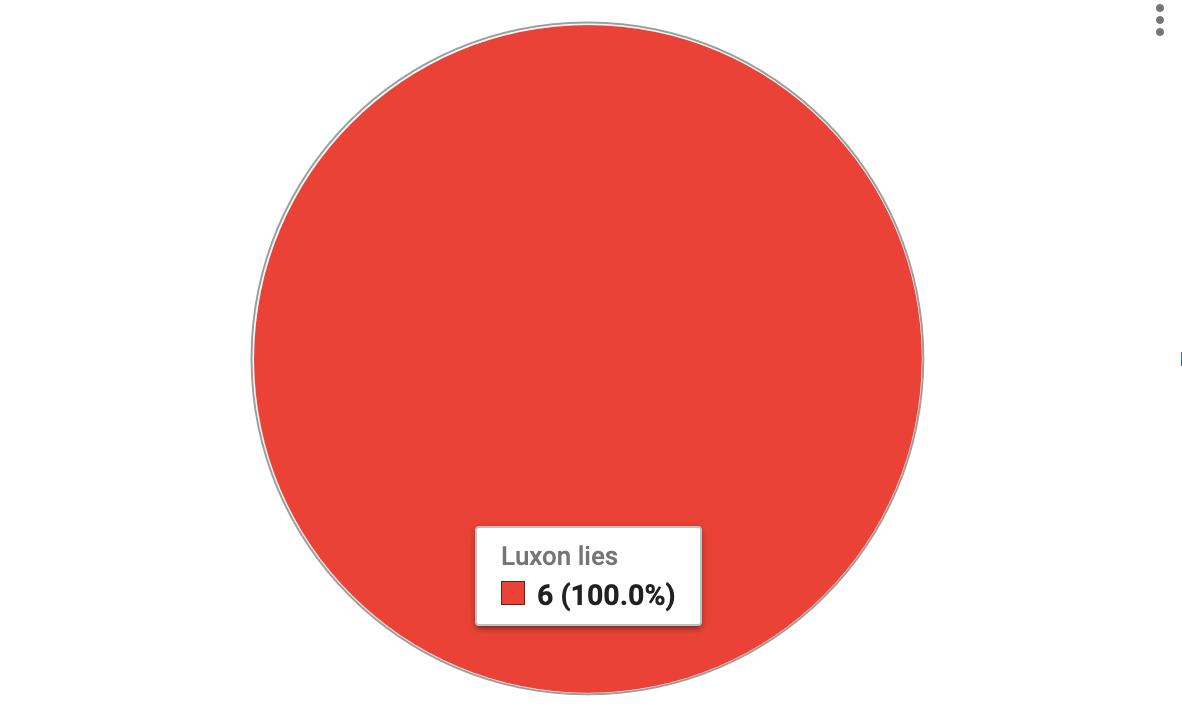
I see red, I see red, I see red. How did the Herald, whose pundits (lest we forget) unanimously gave the debate to Luxon, address the topic of falsehoods in the debate?
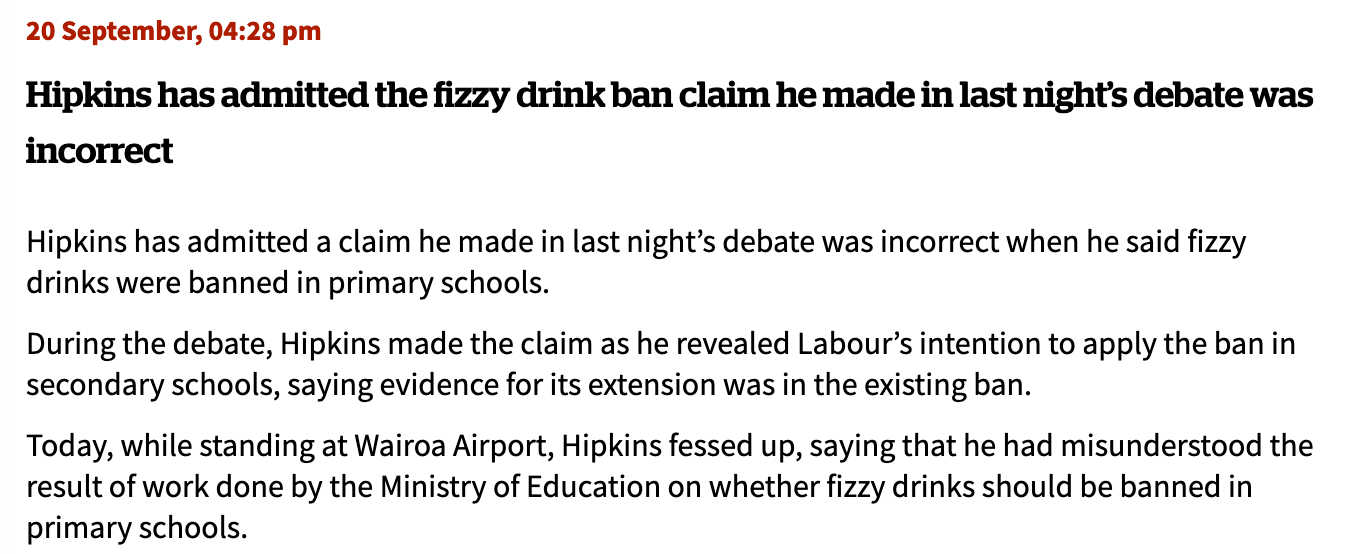
Ah. By correcting something he got wrong, Hipkins has “fessed up.” Oddly, scrolling the same Herald liveblog that details Hipkins’ abject confession on the topic of fizzy drinks, I can’t find any mention or self-correction of Luxon’s multiple debate misstatements. But that’s OK! Optics are what matter most, and — in a time of crisis so acute that the UN Secretary General describes it as humanity having “opened the gates to hell” — we’re blessed to have political journalists to tell us which politicians have mastered the Good Look.

The Metiria Turei Test
It’s Friday, 4 August 2023, and with utterly dull regularity the Post has produced another hit job on non-Tory politician, Wellington mayor Tory Whanau.
Whanau is in the news near constantly because she keeps doing normal human things that, if they were done by any other politician, wouldn’t be news. She stands accused of showing respect to a man who died in a tragedy, forgetting to pay a restaurant bill (that she paid the next day) and making a goofy comment while tipsy, which is something close to 100 percent of the world’s adult population has done. What’s more, in a story so shit it was missing a byline, our bold Fourth Estate was able to reveal she was covertly bringing her dog to the office with such insidious secrecy that the dog had its own Instagram account. Shock horror.
On a related note: I find it notable when unflattering stories run with unflattering photos. Here’s one in which Whanau is pictured looking down. Her eyes appear half-shut and she’s sporting a double chin — as we all do when we look down, which is why photographers tell you to look up when you’re having your picture snapped. It’s the sort of photo so obviously bad that, if you’d taken it of your mate using your smartphone, you’d delete it without thinking.

Fun fact: news photographers are professionals who know what they’re doing, and Tory Whanau is perfectly good-looking. This is done on purpose. Photographers take hundreds of photos at events, most of which are good, then select a few to turn in to an editor and live in a publication’s photo banks. The editors select which photo to run with a given story, and if the story is unflattering, the picture will be often be bad too, to match the story’s tone. I’ve always thought that’s an interesting way to frame things. But I digress.
Today’s scandal is that the mayor traveled somewhere. Not once, but twice. Written up with deadpan excitement by Andrea Vance, whose superpower is creating mountains from molehills, the story reveals, ultimately, that the mayor was criticised by a political enemy who hates her. The piece labours for 456 words to deliver this boring conclusion somewhere in the middle.
Was the criticism in any way pertinent or otherwise made in good faith? Of course not. Here’s what was said by Wellington City Councillor Ray Chung, last seen losing an election to (checks notes) Tory Whanau.
“So much for a Greenie, reducing carbon,” he said. “If that film festival was so important why not come down the day after. But to fly down, then up and then back again?” It appeared hypocritical, he added.
Instead of the more interesting story of a councilor who takes a great steaming dunk on the mayor he’s meant to be working with, Vance writes about a.) the Mayor showing up to things in her capacity as Mayor (interestingly, other Vance stories have criticised her for not attending things) and b.) Chung’s allegation that Whanau is betraying the climate, which she is meant to be a champion of, by having too large an individual carbon footprint.
What the story fails to cover, because doing so would make it clear that it’s not in any way newsworthy, is that carbon footprints were invented by BP, that individuals living in a society created by and for fossil fuel interests have no way of magically opting out, and that even if they did it wouldn’t fucking matter because most carbon emissions are ultimately created by about 100 corporations. Whanau makes the same point in an Instagram post, sans my profanity, but it’s unlikely to lead to any kind of admission that the story was a beat-up. (Instead, it’s more likely to end in a headline screaming something along the lines of MAYOR SLAMS MEDIA “HIT JOB.”) Individual carbon footprints are doubly invidious; not only are they falsely posited as a cure for climate change, but they’re used as a stick to beat “greenies” with every time they do something (like “be alive,” or “their jobs”) that their political opponents deem hypocritical. These attacks are inevitably made in overtly bad faith, but political media keeps giving them validity because it gets clicks and eyeballs.
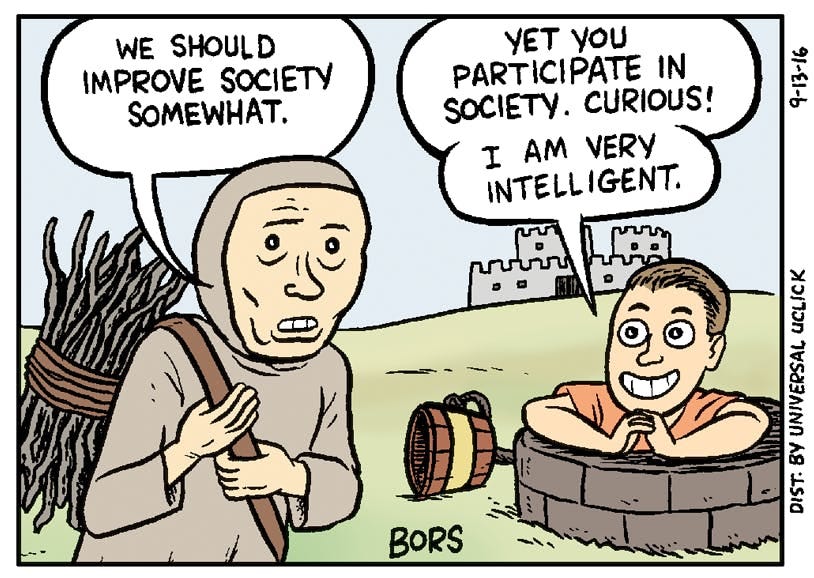
The Nib’s timeless comic Mr Gotcha skewered this shit back in 2016. Note also that it doesn’t actually matter when “greenies” go out of their way to avoid emissions. Greta Thunberg, who won’t fly on principle, was roundly mocked for taking a yacht across the Atlantic to avoid carbon emissions by the exact same people who’d have cagistated her as a hypocrite if she’d chosen to fly or take a carbon-powered ship. Heads they win, tails you lose, climate activists.
What’s happening with Whanau is part of an easily discernible pattern. She’s young, brown, and a woman. Any two of these things would place her outside the political status quo, but she’s got the trifecta, and that means she’s constantly subject to the Metiria Turei test.
The Turing test is a test for whether a computer might be intelligent, and thanks to so-called “Artificial Intelligence” it’s being talked about a lot lately. For politics, I suggest the “Turei test” for a media heuristic that determines if a politician will be subjected to excessive, unfair scrutiny.
Turei, as you might remember, was hounded out of politics almost exactly six years ago for being honest about having committed a crime that’s the modern equivalent of stealing bread to feed your family, decades after the fact.1 It then transpired that she’d fiddled her address in order to vote for a joke political party. For this, she was relentlessly savaged by nearly all of New Zealand’s political media. The feeding frenzy is perhaps best summed up by this comment from Listener journalist Claire de Lore (emphasis added).
Metiria Turei’s spectacular own goal in admitting to benefit and electoral fraud not only effectively ended her career but also took down two of her colleagues, savaged a healthy poll rating and led to Labour’s changing of the guard and reversal of fortunes.
In fact, it was the breathless, skewed, and gleefully cruel media coverage of Turei’s circumstances that effectively ended her career. In that quote, we can see the single weirdest, worst tendency of the political media on full display: the fact that they are active political actors while simultaneously pretending they aren’t. “We don’t make the news, we just report it.” Bullshit! The talking heads of political opponents and lobbyists are deployed to disguise that it’s often the media themselves who criticise, attack, rebuke, slam, or whatever emotive headline word is in favour on a given day. Political media consistently ignore the fact that they wield power through their reporting, and that they tend to frame stories in a way that favours the status quo — while somehow simultaneously excusing their actions with the false inference that politics is all just one big game of sportsball. It’s a shell game that anyone can see through.
Metiria Turei had stolen out of necessity, and that was ignored. The context of her electoral fraud — casting a vote for a joke party — was dismissed by scalp-thirsty political media. So too was the fact that other (white, male) political leaders committed technically legal rorts that cost taxpayers far more than anything Turei had done. The miniscule magnitude of her crime didn’t matter, because hers was the worst of political sins: the “bad look” — as judged by a media who decides both what is “bad” and what gets to be a “look.” Turei was young, brown, a woman. She had the trifecta, and consequently, she was held to a different standard.
That’s the Turei test in action. New Zealand’s political media, in their slavish, semiconsious devotion to the status quo, will make damn sure that other young, brown, female politicians are subjected to it too.
-
Many beneficiaries are made into liars about “being in a relationship” because, if they are honest, they’ll be cast into financial hell for the crime of having sex while poor. ↩
-
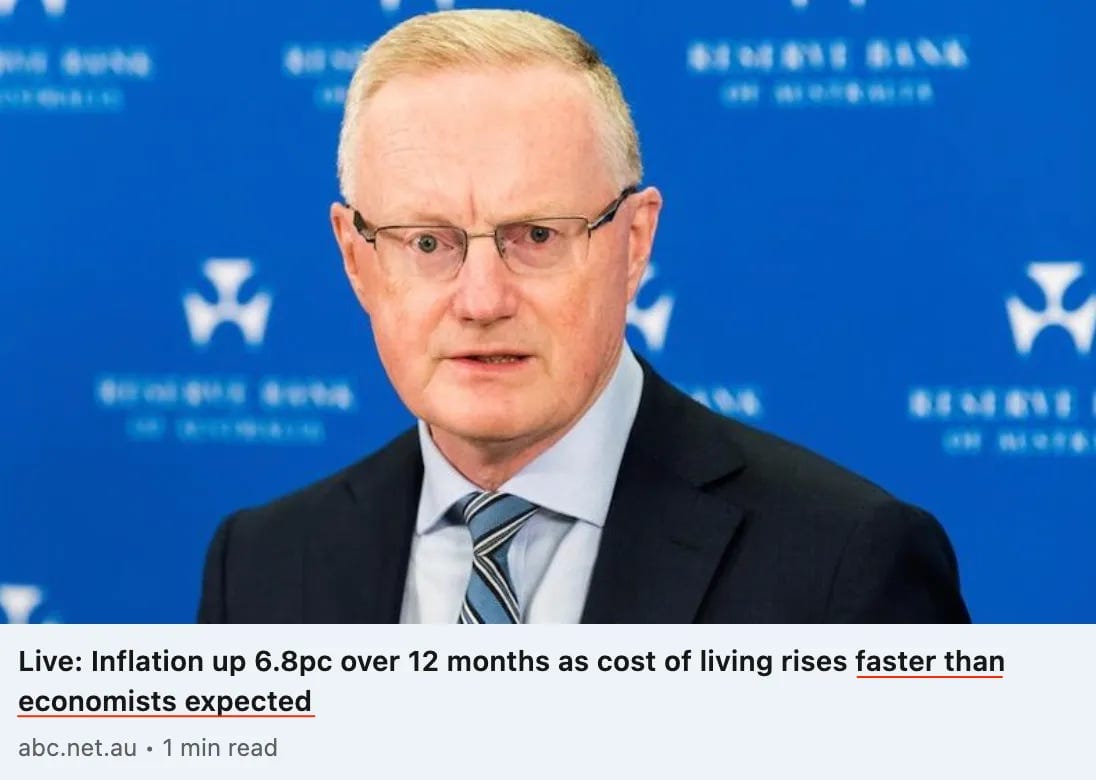
Ecomedy of Economicerrors
The below image of a harried-looking nerd popped up on my LinkedIn feed today, and of course, you’re right. It’s my fault for using LinkedIn. But it did prompt me to whip this article together, which turned out to be easy, because it’s been brewing for a while.
I love economics. It’s always funny, and in recent times it’s been incredibly consistent, generating at least one belly-laugh a day, usually in the mornings when an earnest news media reports the latest round of prognostications like it’s a message from God.
Sometimes, though, something special comes along. My favourite economics article in recent times has to be this, from the Financial Times, with the apparently irony-free headline “Why are central bank forecasts so wrong?” Why indeed? The whole article is 100 percent worth a read, ideally without any liquids to hand to avoid the possibility of spit-takes, but I can’t resist posting some highlights.
Advanced economies are experiencing the most acute — and most enduring — outbreak of inflation for a generation. Yet almost all rate-setters failed to spot the degree to which price pressures would ratchet up — and stick around, despite record amounts of monetary and fiscal stimulus. Most of the Federal Reserve’s rate-setters failed to foresee that inflation would ever rise, and then overestimated the speed of its decline. Economists at the BoE and the European Central Bank underestimated the scale and persistence of inflation. Across the world, poor forecasts have contributed to central bankers failing to do their main job: maintaining price stability.
REALLY. Look, I’m just a layperson, but here’s a thought: Businesses exist to make profits and satisfy shareholders. No, that’s not ideal for… anything1, but that’s not my fault, it’s Milton Friedman’s. So, using the great man’s own rubric, if you just kind of give businesses lots of money, as central banks did during the early stages of the pandemic, they will generally:
a. Keep it and report amazing profits, inflating share prices, or,
b. There is no b.
Anyway. With prices (inflation) having increased from the colossal supply chain crunch engendered by the pandemic and corporate profiteers keen to capitalise on it, the economists who run central banks swung into action. They knew just what to do: increase interest rates, forcing businesses to fire people.2 Newly impoverished, these consumers would make the economically rational decision to stop buying things like… hey, what’s actually going up in price to cause this inflation anyway?
Food was the largest contributor to the March 2023 annual inflation rate. This was due to rising prices for vegetables, ready-to-eat food, and milk, cheese, and eggs.
Vegetable prices increased 22 percent in the 12 months to March 2023, while ready-to-eat food and milk, cheese and eggs increased 9.7 percent and 15 percent, respectively.
Ah. It’s food. So yeah, when interest rates went up, and people didn’t make the economically rational decision to starve, sellers put their prices up, because it turns out the incredibly obvious way to deal with increased costs and keep making exorbitant profits with a product that people mysteriously won’t stop buying is to put your prices up — which, for those keeping score at home, is what inflation is.
SO WEIRD. No wonder economists didn’t see it coming! Better put up interest rates again, that’ll help.
The Financial Times article continues, like the world’s driest stand-up comedian:
But what forecasts failed to show was that those rules only hold when inflation is broadly stable. Once price pressures soar — and stay high — people begin to believe that “the central bank is now talking nonsense”. Scepticism abounds, and recent inflation readings come to matter more than central banks’ insistence that their policies can quell price pressures.
Yes, people will generally believe that an institution (founded with the express intention and ability to ruin people’s lives en masse) is talking nonsense when its confident forecasts are confounded on a more or less daily basis by the ineffable nature of inconvenient fucking reality. What to do about this public distaste for economic predictions? Let’s ask economists, as the article rumbles inexorably towards this incredible punchline:
While other organisations have been less defensive, economists elsewhere caution that the public should focus less on whether or not projections turn out to be correct. That, they argue, is impossible and the public should focus more on whether the projections say something insightful about the economy at this point in time.
That is so improbably funny that without a finely-honed economic sense of humour like mine you might have missed the joke. Let me explain while trying not to laugh too hard because I still can’t believe they said the quiet part quite so loud: because their predictions keep turning out to be wrong, economists are asking us to take a radically different view of the word “prediction.” Rather than assessing an economic prediction’s success using the conventional calibration — whether or not it happens — we are asked to reflect on whether the prediction tells us anything about the present.
In other words, economics is proudly and loudly telling us not to use it for what it’s almost exclusively used for: what might happen in the future. Instead, economists want us to look at economics like this:

This is Jackson Pollock’s “Convergence,” 1952, although a better title might have been “Economic Prediction.” Or maybe it’s more like this:
Now that economists are finally at the stage of admitting that economic orthodoxy is actually a very large and expensive performance art piece that can’t predict anything but (coincidentally?) is very good for rich people’s bank balances, I hope we can consign it to where it clearly belongs: a museum.
